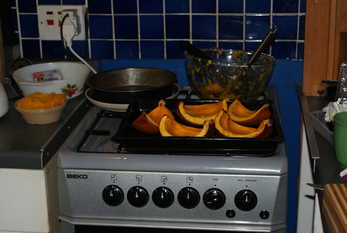
Night Of The Living Pumpkins
Following on the overwhelming success of my cute landlady and my last feast
we booked ourselves a
whole Night of Pumpkin treats.
This time it was my friends who turned up and Aline's who bombed.
Alex brought some of his tasty French Onion Soup, Andrew and Ztacci brought beer just to emphasise the fact that I'm on the dry and Jenny brought a rubber ducky.
Since it's now over two weeks since Hallowe'en all the large pumpkins in our universe have turned into coaches or ceased to exist, so things weren't looking promising for the annual Chicken In A Pumpkin. I would have bought one earlier, but I wasn't sure that it would have kept well enough to still be edible so I started considering a brand new concept - Partridge In A Pumpkin. Actually I was starting to get quite keen on the idea, thinking it would probably be easier to find a good fit between pumpkin and bird, but then we went to the Farmers' Market on Saturday and lo and behold found the last large pumpkin in the world. So I bought it. It's going to be a Chumpkin evening after all. Hurrah!
Actually one of the advantages of missing out on the Hallowe'en pumpkin frenzy is that afterwards you can buy genuine culinary varieties, which definitely taste far better than their sour, stringy, watery overgrown cousins, even if they are much smaller. And we needed about half a dozen of the suckers.
The farmer's market also coughed up an incredibly expensive organic chicken, which ought to taste bloody fabulous for the price, but I was maybe a little cautious with the size and ended up with a very loose fit. It's easier to accommodate a too-small chicken by packing the pumpkin with extra stuffing than trying surgically reduce a too-large one, but from previous experience I know that this packed stuffing ends up too wet to eat.
With Christmas on its way, and with it the need to plan a stuffing for my family's traditional Festive Goose I thought I'd quite like to try a quince stuffing this year (I don't know why, but I've had "quince" and "kumquats" in my head for a couple of weeks now) having abandoned my original idea of working something around mango (too Eastern).
As you may recall from earlier meals, cooking for Aline brings its own special challenges (though not so very unusual in this increasingly food-fussy age), with her intolerance of all things fleshly, lactic or glutenous. Suffice to say she was not about to partake of the Chicken, so there I had a free hand, but had to do some dodgy adaptions for my other dishes.
So if they turned out rubbish - there's my excuse!
menu
This time it was my friends who turned up and Aline's who bombed.
Alex brought some of his tasty French Onion Soup, Andrew and Ztacci brought beer just to emphasise the fact that I'm on the dry and Jenny brought a rubber ducky.
Since it's now over two weeks since Hallowe'en all the large pumpkins in our universe have turned into coaches or ceased to exist, so things weren't looking promising for the annual Chicken In A Pumpkin. I would have bought one earlier, but I wasn't sure that it would have kept well enough to still be edible so I started considering a brand new concept - Partridge In A Pumpkin. Actually I was starting to get quite keen on the idea, thinking it would probably be easier to find a good fit between pumpkin and bird, but then we went to the Farmers' Market on Saturday and lo and behold found the last large pumpkin in the world. So I bought it. It's going to be a Chumpkin evening after all. Hurrah!
Actually one of the advantages of missing out on the Hallowe'en pumpkin frenzy is that afterwards you can buy genuine culinary varieties, which definitely taste far better than their sour, stringy, watery overgrown cousins, even if they are much smaller. And we needed about half a dozen of the suckers.
The farmer's market also coughed up an incredibly expensive organic chicken, which ought to taste bloody fabulous for the price, but I was maybe a little cautious with the size and ended up with a very loose fit. It's easier to accommodate a too-small chicken by packing the pumpkin with extra stuffing than trying surgically reduce a too-large one, but from previous experience I know that this packed stuffing ends up too wet to eat.
With Christmas on its way, and with it the need to plan a stuffing for my family's traditional Festive Goose I thought I'd quite like to try a quince stuffing this year (I don't know why, but I've had "quince" and "kumquats" in my head for a couple of weeks now) having abandoned my original idea of working something around mango (too Eastern).
As you may recall from earlier meals, cooking for Aline brings its own special challenges (though not so very unusual in this increasingly food-fussy age), with her intolerance of all things fleshly, lactic or glutenous. Suffice to say she was not about to partake of the Chicken, so there I had a free hand, but had to do some dodgy adaptions for my other dishes.
So if they turned out rubbish - there's my excuse!
menu
Pumpkin "Damper" Bread
Thai-Spiced Pumpkin Soup
Roasted Pumpkin Salad
Chumpkin
Toasted Pumpkin Seeds
Chicken-In-A-Pumpkin. My seasonal centrepiece.
Pumpkin Bake
Well, you should do something with all those seeds.
Pumpkin Pie
To finish. What else?
Pumpkin Damper Bread
bread veg
I adapted this recipe
from Titania Hardie's Hubble Bubble Cookbook.
It's one I have tried very successfully before, but needed to make it gluten and lactose friendly for Aline,
so substituted soya margarine for the butter,
gluten-free flour (with added Xanthan gum) for the regular flour,
and soy milk for the regular milk.
Fortunately Aline has a very fine collection of plant pots available for bread baking.
Incidentally, Aline assured me that soy milk was an excellent milk substitute and that I would have trouble distinguishing it from the real thing. She was wrong. It's a thick glutinous white liquid that smells slightly sour and has the texture of phlegm. And there its resemblance to milk ends.
I then followed Titania's Damper bread method, but the bread hardly rose at all, and was still uncooked after 15 minutes. I stuck the pots back in the oven for another 15 minutes, after which the bread at least was cooked, though still unrisen.
Surprisingly the bread tasted rather good nonetheless.
So a complete gluten/lactose-free success!
Fortunately Aline has a very fine collection of plant pots available for bread baking.
Incidentally, Aline assured me that soy milk was an excellent milk substitute and that I would have trouble distinguishing it from the real thing. She was wrong. It's a thick glutinous white liquid that smells slightly sour and has the texture of phlegm. And there its resemblance to milk ends.
I then followed Titania's Damper bread method, but the bread hardly rose at all, and was still uncooked after 15 minutes. I stuck the pots back in the oven for another 15 minutes, after which the bread at least was cooked, though still unrisen.
Surprisingly the bread tasted rather good nonetheless.
So a complete gluten/lactose-free success!
Ingredients
- 2oz (60g) soya margarine
- 12 oz (350g) gluten-free flour with Xanthan gum
- 1½ teaspoons salt
- 1¾ fl oz (50ml) soy milk
- 1¾ fl oz (50ml) water
- 1½ lb (675g) cooked and mashed pumpkin.
That ol' Chicken In A Pumpkin thing.
Chumpkin
main fowl
The usual Chicken In A Pumpkin setup,
I calculated 20 minutes per pound plus 20 minutes cooking time for the overall weight
of stuffed pumpkin.
For my (approximately, since I didn't have scales with enough range) 10lb chumpkin,
that worked out at around 4 hours.
I actually allowed a bit more cooking time,
gradually adjusting the oven temperature down as the chicken cooked and the pumpkin darkened
so it wouldn't burn.
This time I also made sure the bird was properly cooked using a meat thermometer
to avoid any risk of poisoning.
Because we had a number of other dishes to prepare in the oven for the main course, I let the chumpkin stand, covered in tin foil, for about an hour before we ate it. It held its heat pretty well I thought.
Because we had a number of other dishes to prepare in the oven for the main course, I let the chumpkin stand, covered in tin foil, for about an hour before we ate it. It held its heat pretty well I thought.
Serves A Dinner Party
Ingredients
- A chicken
- A pumpkin
- some stuffing
Make the stuffing.
Cut the lid off the pumpkin and reserve to bake separately.
Clean out the pumpkin of seeds and stringy goop with a spoon.
Roast the chicken for about 20 minutes in a hot oven to crisp up the skin.
Fill the chicken with stuffing and the pumpkin with chicken.
Pack any huge gaps around the chicken with more stuffing.
Put the chumpkin in a baking dish large enough to hold it if the pumpkin should collapse.
Bake the chumpkin at Gas 6 for 20 minutes per pound plus 20 minutes.
Watch the chumpkin for browning/burning after half-time and reduce the heat as necessary (you can wrap the whole thing in foil if you prefer to better protect the skin).
Using a meat thermometer to check the chicken is cooked is a really good idea!
Cooked, the chumpkin will stay warm covered in tin foil for 30-60 minutes if necessary. dark chicken stock.
You can use quite a lot of the leftover pumpkin flesh (and anything else) too (I used about half of mine, plus some tomato bits and the stock is delicious!).
Cut the lid off the pumpkin and reserve to bake separately.
Clean out the pumpkin of seeds and stringy goop with a spoon.
Roast the chicken for about 20 minutes in a hot oven to crisp up the skin.
Fill the chicken with stuffing and the pumpkin with chicken.
Pack any huge gaps around the chicken with more stuffing.
Put the chumpkin in a baking dish large enough to hold it if the pumpkin should collapse.
Bake the chumpkin at Gas 6 for 20 minutes per pound plus 20 minutes.
Watch the chumpkin for browning/burning after half-time and reduce the heat as necessary (you can wrap the whole thing in foil if you prefer to better protect the skin).
Using a meat thermometer to check the chicken is cooked is a really good idea!
Cooked, the chumpkin will stay warm covered in tin foil for 30-60 minutes if necessary. dark chicken stock.
You can use quite a lot of the leftover pumpkin flesh (and anything else) too (I used about half of mine, plus some tomato bits and the stock is delicious!).
Pumpkin Bake
side main veg vegan
I thought a dish along the lines of Elizabeth David's Courgette Bake
might also work with pumpkin using a tomato base to replace the missing moisture
and cauliflower to break up the pumpkinness.
I also wanted to introduce a slightly sour flavour and would have used ricotta cheese or yoghurt,
but Aline's lactose intolerance precluded those.
So I decided to try and work in some tagine-style flavours using black olives and preserved lemons.
I must confess I had expected the pumpkin to disintegrate much more than it did
(and have more flavour also - damn those culinary pumpkins).
The verdict: Dry, dull and tasteless.
The dish might have potential (particularly the black olive and the cauliflower),
but would need a good deal more work.
Served 6
Ingredients
- ten shallots (or a couple of onions), sliced
- 1 teaspoon saffron
- 2" ginger, grated
- 1 small cauliflower, separated into florets
- 6 cloves garlic
- a dozen black olives
- ½ a preserved lemon, in very thin slices
- pumpkin, chopped into ½" cubes
- olive oil
- 4 tomatoes
- 1 teaspoon coriander seeds, crushed
- a glass white wine
- 2 cups Soft breadcrumbs, or to cover or some hideous gluten-free alternative
- any herbs you fancy I didn't
- liquor(?)
Grind the coriander seeds fairly thoroughly in a spice grinder.
Peel, de-seed and cut the pumpkin into chunks, sprinkle generously with sea salt and the crushed coriander seeds then roast in a hot oven until cooked through and starting to soften.
Make a small cross in each tomato near the stalk end and dunk them in boiling water. Peel, de-seed and dice.
Fry the cauliflower pieces in olive oil until they brown, and set aside
Soften the onions, add the garlic, ginger, saffron, cumin (which I skipped), coriander, tomatoes and cook with the wine until reduced to a thickish purée.
Mix the pumpkin, cauliflower, olives, herbs (if you like), Lay on a layer of preserved lemons.
Cover with soft breadcrumbs and dot with butter.
Peel, de-seed and cut the pumpkin into chunks, sprinkle generously with sea salt and the crushed coriander seeds then roast in a hot oven until cooked through and starting to soften.
Make a small cross in each tomato near the stalk end and dunk them in boiling water. Peel, de-seed and dice.
Fry the cauliflower pieces in olive oil until they brown, and set aside
Soften the onions, add the garlic, ginger, saffron, cumin (which I skipped), coriander, tomatoes and cook with the wine until reduced to a thickish purée.
Mix the pumpkin, cauliflower, olives, herbs (if you like), Lay on a layer of preserved lemons.
Cover with soft breadcrumbs and dot with butter.
In deference to Aline's culinary peculiarities,
I used her strange rice-based crumb mix
and blended it up with soya margarine until it looked something like breadcrumbs (though still smelling of axle grease).
This topping seems able suck all the moisture from the world and yet still lie there like a heavy fall of moondust, so maybe things would have worked out better with real bread.
Bake at Gas 6 for 45 minutes.
This topping seems able suck all the moisture from the world and yet still lie there like a heavy fall of moondust, so maybe things would have worked out better with real bread.
Rubbish!
I blame the topping. And the filling. That was rubbish too.
It managed to have both too many competing flavours (I think I should have skipped the preserved lemon) and not enough taste (too dry, and the pumpkin was surprisingly tasteless).
Ho hum.
I blame the topping. And the filling. That was rubbish too.
It managed to have both too many competing flavours (I think I should have skipped the preserved lemon) and not enough taste (too dry, and the pumpkin was surprisingly tasteless).
Ho hum.
Quince Hazelnut stuffing
side ingredient veg
Makes enough for about 3 chickens, or 1 chumpkin
Ingredients
- 2 quince, probably around 1½ cups chopped quince flesh (they're surprisingly massive things, quince)
- 2 teaspoons brown sugar
- butter
- hazelnuts, maybe 1½ cups, roughly chopped Too much and too chunky?
- finely chopped onions
- 6 cloves garlic
- breadcrumbs, almost a whole baguette - probably 2 pints
- salt, herbs?
Roast the hazelnuts in a hot oven for 5 minutes.
Roll them in a tea towel to remove the skins.
Chop quite finely.
Peel, core and chop your quince.
Finely chop the onions and garlic.
Crumb the bread with a food processor or grater. I left the crust on this time because I didn't have much bread, but I would normally cut those off.
Heat a little butter in a frying pan, add the quince, sprinkle with the sugar. Cook, turning, for 15 minutes until they begin to nicely caramelise, then set aside. In more butter, fry the onions and garlic to soften.
Mix everything together (you could also add an egg or a little stock to soften things up), and stuff into the bird, and the pumpkin.
Peel, core and chop your quince.
Finely chop the onions and garlic.
Crumb the bread with a food processor or grater. I left the crust on this time because I didn't have much bread, but I would normally cut those off.
Heat a little butter in a frying pan, add the quince, sprinkle with the sugar. Cook, turning, for 15 minutes until they begin to nicely caramelise, then set aside. In more butter, fry the onions and garlic to soften.
Mix everything together (you could also add an egg or a little stock to soften things up), and stuff into the bird, and the pumpkin.
The stuffing was quite nice really, and popular,
but I wasn't keen on the big chunks of hazelnut.
I think you'd want to chop them more finely, and maybe use less?
The best stuffing was from the top of the chumpkin, which had picked up some juices from the bird and the squash, but stayed dry during the roasting process (since I left the lid off).
The next best bit was from inside the chicken. The stuffing from deep around the chicken was a bit too soggy really, though the leftovers baked up quite nicely left at the bottom of a moderate oven for two hours the next day.
The best stuffing was from the top of the chumpkin, which had picked up some juices from the bird and the squash, but stayed dry during the roasting process (since I left the lid off).
The next best bit was from inside the chicken. The stuffing from deep around the chicken was a bit too soggy really, though the leftovers baked up quite nicely left at the bottom of a moderate oven for two hours the next day.
Thai-spiced Pumpkin Soup
soup curry veg
Keep in mind that different Thai curry pastes have differing strengths.
Start with a teaspoon to start and then build from there until the soup has a level of spiciness and flavor
that works for your palate.
Top with toasted pumpkin seeds.
Serves 6
Ingredients
- 2 acorn squash, pumpkins, or other smallish winter squash
- 3 tablespoons unsalted butter, room temperature
- 1 14-ounce can coconut milk
- 1 teaspoon (or more) red Thai curry paste
- water
- 2 teaspoons fine grain sea salt (or to taste)
Preheat the oven to 375 degrees and place the oven racks in the middle.
Carefully cut each squash/pumpkin into halves (or quarters). Slather each piece of squash with butter, sprinkle generously with salt, place on a baking sheet skin sides down, and place in the oven. Roast for about an hour or until the squash is tender throughout.
When the pumpkin/squash are cool enough to handle scoop it into a large pot over medium high heat. Add the coconut milk and curry paste and bring to a simmer. Remove from the heat and puree with a hand blender, you should have a very thick base at this point. Now add water a cup at a time pureeing between additions until the soup is the consistency you prefer - a light vegetable stock would work here as well. Bring up to a simmer again and add the salt (and more curry paste if you like, I used just shy of 6 teaspoons but the curry paste I use is not over-the-top spicy).
Carefully cut each squash/pumpkin into halves (or quarters). Slather each piece of squash with butter, sprinkle generously with salt, place on a baking sheet skin sides down, and place in the oven. Roast for about an hour or until the squash is tender throughout.
When the pumpkin/squash are cool enough to handle scoop it into a large pot over medium high heat. Add the coconut milk and curry paste and bring to a simmer. Remove from the heat and puree with a hand blender, you should have a very thick base at this point. Now add water a cup at a time pureeing between additions until the soup is the consistency you prefer - a light vegetable stock would work here as well. Bring up to a simmer again and add the salt (and more curry paste if you like, I used just shy of 6 teaspoons but the curry paste I use is not over-the-top spicy).
A bit raw on the spices for my taste.
Aline made this without butter obviously (too lactic), and used green Thai curry paste. Lots of green Thai curry paste.
The result was a bit over-spiced (and you don't hear me saying that very often!), and I think the paste might be better fried to get rid of some of the harshness, though that does reduce slightly if you keep cooking the soup for a while.
Aline made this without butter obviously (too lactic), and used green Thai curry paste. Lots of green Thai curry paste.
The result was a bit over-spiced (and you don't hear me saying that very often!), and I think the paste might be better fried to get rid of some of the harshness, though that does reduce slightly if you keep cooking the soup for a while.
Roasted Pumpkin Salad
salad veg
Serves 4Ingredients
- 3 cups of pumpkin (or other winter squash), peeled and cut into 1-inch cubes
- extra-virgin olive oil
- fine grain sea salt
- 12 tiny red onions or shallots, peeled (OR 3 medium red onions peeled and quartered)
- 2 cups cooked wild rice*
Dressing:
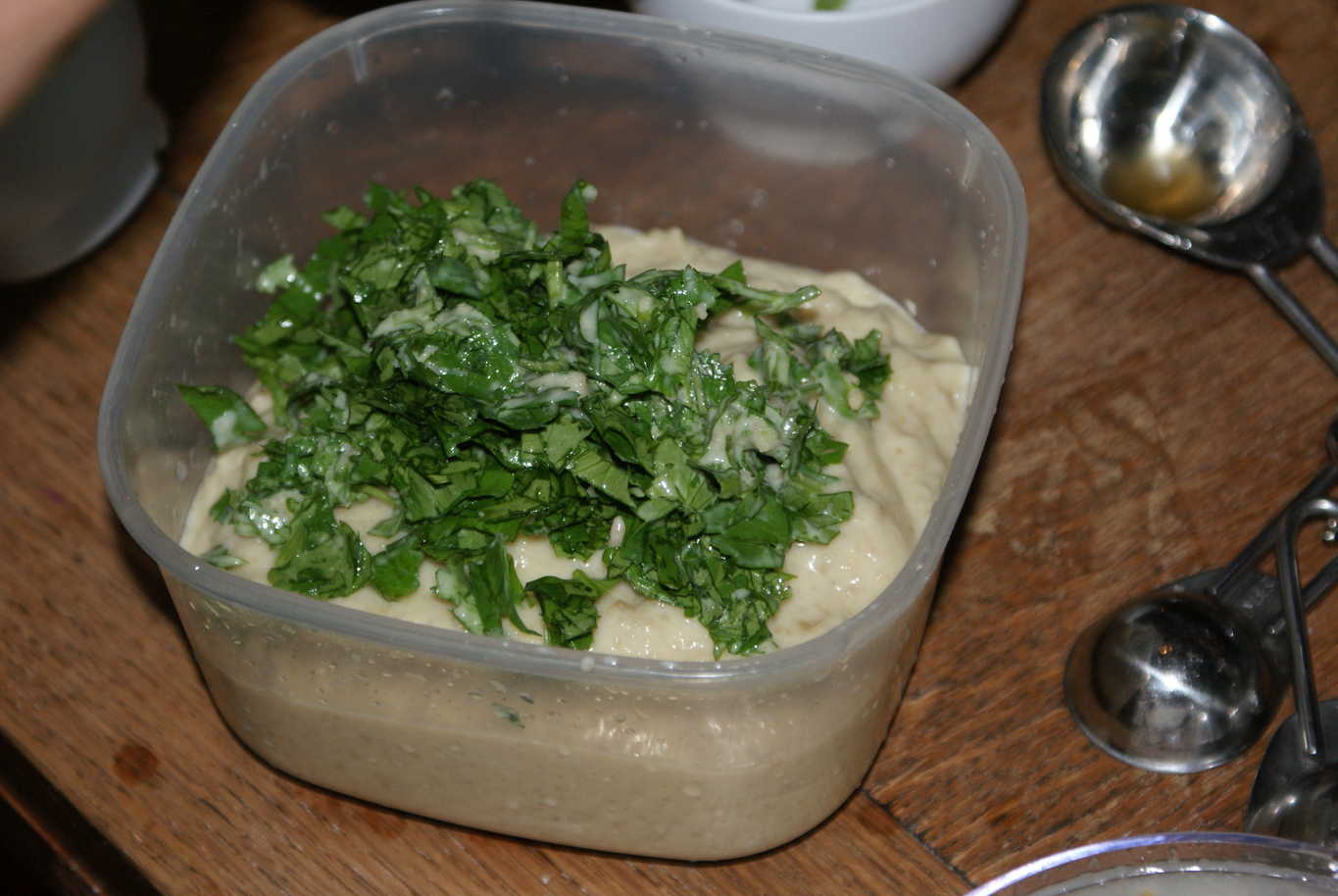
- 1/3 cup sunflower seeds
- 1/3 cup olive oil
- 2 tablespoons lemon juice
- 1/4 teaspoon salt
- 1 tablespoon honey
- 2 tablespoons warm water
- 1/2 cup cilantro, finely chopped
Preheat oven to 375.
Toss the pumpkin in a generous splash of olive oil along with a couple pinches of salt, and turn out onto a baking sheet. At the same time, toss the onions with a bit of olive oil, sprinkle with salt, and turn out onto a separate baking sheet. Roast both for about 45 minutes, or until squash is brown and caramelized. The same goes for the onions, they should be deeply colored, caramelized, and soft throughout by the time they are done roasting. You'll need to flip both the squash and onion pieces once or twice along the way - so it's not just one side that is browning.
In the meantime, make the dressing. With a hand blender or food processor puree the sunflower seeds, olive oil, lemon juice, salt, and honey until creamy. You may need to add a few tablespoons of warm water to thin the dressing a bit. Stir in the cilantro, saving just a bit to garnish the final plate later. Taste and adjust seasonings (or flavors) to your liking - I usually need to add a touch more salt with this dressing.
In a large bowl, toss the wild rice with a large dollop of the dressing. Add the onions, gently toss just once or twice. Turn the rice and onions out onto a platter and top with the roasted squash (I'll very gently toss with my hands here to disperse the pumpkin a bit). Finish with another drizzle of dressing and any remaining chopped cilantro.
Toss the pumpkin in a generous splash of olive oil along with a couple pinches of salt, and turn out onto a baking sheet. At the same time, toss the onions with a bit of olive oil, sprinkle with salt, and turn out onto a separate baking sheet. Roast both for about 45 minutes, or until squash is brown and caramelized. The same goes for the onions, they should be deeply colored, caramelized, and soft throughout by the time they are done roasting. You'll need to flip both the squash and onion pieces once or twice along the way - so it's not just one side that is browning.
In the meantime, make the dressing. With a hand blender or food processor puree the sunflower seeds, olive oil, lemon juice, salt, and honey until creamy. You may need to add a few tablespoons of warm water to thin the dressing a bit. Stir in the cilantro, saving just a bit to garnish the final plate later. Taste and adjust seasonings (or flavors) to your liking - I usually need to add a touch more salt with this dressing.
In a large bowl, toss the wild rice with a large dollop of the dressing. Add the onions, gently toss just once or twice. Turn the rice and onions out onto a platter and top with the roasted squash (I'll very gently toss with my hands here to disperse the pumpkin a bit). Finish with another drizzle of dressing and any remaining chopped cilantro.
* To cook wild rice:
Rinse 1 1/2 cups wild rice. In a medium sauce pan bring the rice and 4 1/2 cups salted water to a boil. Reduce to a simmer. Cook for 40 minutes or until rice is tender and splitting open, stirring occasionally. You'll have enough for this recipe and some leftover.
Rinse 1 1/2 cups wild rice. In a medium sauce pan bring the rice and 4 1/2 cups salted water to a boil. Reduce to a simmer. Cook for 40 minutes or until rice is tender and splitting open, stirring occasionally. You'll have enough for this recipe and some leftover.
When Aline made the dressing I thought it was pretty tasty,
but somehow it got completely submerged in the salad, and the result was a bit on the dull side.
Perhaps there was just too much rice?
Perhaps there was just too much rice?
Spice-Kissed Pumpkin Pie
dessert sweet veg
... freshly ground spices, make all the difference in a recipe like this.
For the filling, you can also substitute roasted sweet potatoes or other roasted winter squash as the base ingredient.
If you are pinched for time you can also use canned pumpkin puree (but I really prefer the flavor that comes from roasting my own).
If you used canned puree, be sure it is pure, non-spiced pumpkin puree.
You can certainly use a store-bought crust if you like, for a pie like this I use a standard pie dough recipe (pate brisee).
I use whole wheat pastry flour in place of all-purpose flour.
Alternate crust option:
you can make a simple pat-in-pan graham cracker pie crust by giving 2 cups well-crushed graham cracker crumbs, 1/3 cup melted butter, and 2 tablespoons of honey a whirl in a food processor. Then press (intensively) into a 9-inch pie pan, and proceed with filling.
You can use the filling in tarts, or for individual pies/tarts as well. I love to use deep, dark Muscovado sugar in place of standard brown sugar for its flavor, but some people are turned off by the darker color it lends to the filling.
Alternate crust option:
you can make a simple pat-in-pan graham cracker pie crust by giving 2 cups well-crushed graham cracker crumbs, 1/3 cup melted butter, and 2 tablespoons of honey a whirl in a food processor. Then press (intensively) into a 9-inch pie pan, and proceed with filling.
You can use the filling in tarts, or for individual pies/tarts as well. I love to use deep, dark Muscovado sugar in place of standard brown sugar for its flavor, but some people are turned off by the darker color it lends to the filling.
Makes one 9 or 10-inch pie
Ingredients
- 1 pie crust (of your choice), see pat-in-pan option
- 2 cups hazelnuts (divided) , toasted
- 1/2 cup brown sugar
- 1 tablespoon pumpkin pie spice blend*
- 1 teaspoon salt
- 1 tablespoon arrowroot (or cornstarch)
- 1 1/2 cups of roasted pumpkin puree*
- 1 teaspoon vanilla extract
- 3 extra large eggs PLUS one for glaze, lightly beaten
- 1 cup coconut milk
Preheat oven to 350 degrees, racks in the middle.
Puree 1 1/2 cups of the toasted hazelnuts in a food processor until they turn into a hazelnut paste, past the 'crumble' stage. Set aside. Chop the remaining 1/2 cup of hazelnuts and set aside separately, these will be sprinkled on top after the pie is baked.
To make the pumpkin pie filling, whisk together the brown sugar, pumpkin pie spice blend, salt, and arrowroot. Stir in the pumpkin puree, and vanilla. Now stir in the eggs and coconut milk until just combined. Set aside.
Before filling the pie crust, crumble the hazelnut paste on top of the pie dough into the pie plate, quickly and gently press it into a thin layer across the bottom creating a layer of hazelnuts that will sit between the dough and the filling apparently helping to keep the crust from getting soggy. Using the last egg gently brush the decorative edges of the pie dough. Use a fork to prick the pie dough a few times to prevent air bubbles. Fill the pie crust with the filling and bake for about 50 minutes - the center of the pie should just barely jiggle when you move the pie - the edges should be set.
Let the pie cool a bit, this makes slicing less messy. Serve straight or with a dollop of bourbon-spiked, sweetened whipped cream or creme fraiche, and a sprinkling of chopped hazelnuts.
Puree 1 1/2 cups of the toasted hazelnuts in a food processor until they turn into a hazelnut paste, past the 'crumble' stage. Set aside. Chop the remaining 1/2 cup of hazelnuts and set aside separately, these will be sprinkled on top after the pie is baked.
To make the pumpkin pie filling, whisk together the brown sugar, pumpkin pie spice blend, salt, and arrowroot. Stir in the pumpkin puree, and vanilla. Now stir in the eggs and coconut milk until just combined. Set aside.
Before filling the pie crust, crumble the hazelnut paste on top of the pie dough into the pie plate, quickly and gently press it into a thin layer across the bottom creating a layer of hazelnuts that will sit between the dough and the filling apparently helping to keep the crust from getting soggy. Using the last egg gently brush the decorative edges of the pie dough. Use a fork to prick the pie dough a few times to prevent air bubbles. Fill the pie crust with the filling and bake for about 50 minutes - the center of the pie should just barely jiggle when you move the pie - the edges should be set.
Let the pie cool a bit, this makes slicing less messy. Serve straight or with a dollop of bourbon-spiked, sweetened whipped cream or creme fraiche, and a sprinkling of chopped hazelnuts.
Aline went for the pat-in-pan pie crust option,
and I made some (delicious) maple-syrup squirty cream
to go with.
The crust was thick and oleaginous and the filling a bit too dry and heavy for my taste though. I don't think I'd try it again.
Note To Self:
Remember to give the foamer a shake and try an experimental squirt into the sink before you cover the guests in farty foam.
The crust was thick and oleaginous and the filling a bit too dry and heavy for my taste though. I don't think I'd try it again.
Kathy's Pumpkin Pie Spice Blend
ingredient veg vegan
Makes 2 tablespoonsIngredients
- 1 tablespoon freshly ground cassia cinnamon
- 3/4 teaspoon freshly ground allspice
- scant 1/2 teaspoon freshly ground cloves
- 1 1/2 teaspoons ground ginger (pre ground)
Use a coffee grinder to separately grind each of the following: cinnamon, allspice, and cloves.
Smash the cinnamon a bit before grinding it. The spices should be powder-fine, and sifted into a bowl together.
Stir in the ground ginger, and use in any recipe calling for a pumpkin pie spice blend.
Roasted Pumpkin Purée
ingredient veg vegan
Makes a couple of pounds of puréeIngredients
- 1 3 lb. sugar pie pumpkin
- 2 tablespoons olive oil
- salt
Preheat oven to 400 degrees.
Carefully cut the pumpkin into four big wedges - get rid of the stem.
Scoop out the seeds and pulp (you can toast the seeds if you like),
drizzle then rub the pumpkin wedges with olive oil,
sprinkle generously with salt, and then bake on a baking sheet (middle rack) until tender throughout - about an hour.
Scoop flesh out of the skins and puree with a hand blender or mash well by hand.
It is easier to peel the pumpkin once it's cooked and the flesh easily separates with a spoon,
but you can also peel and chop the pumpkin and just simmer it up instead.
Crab And Meringue
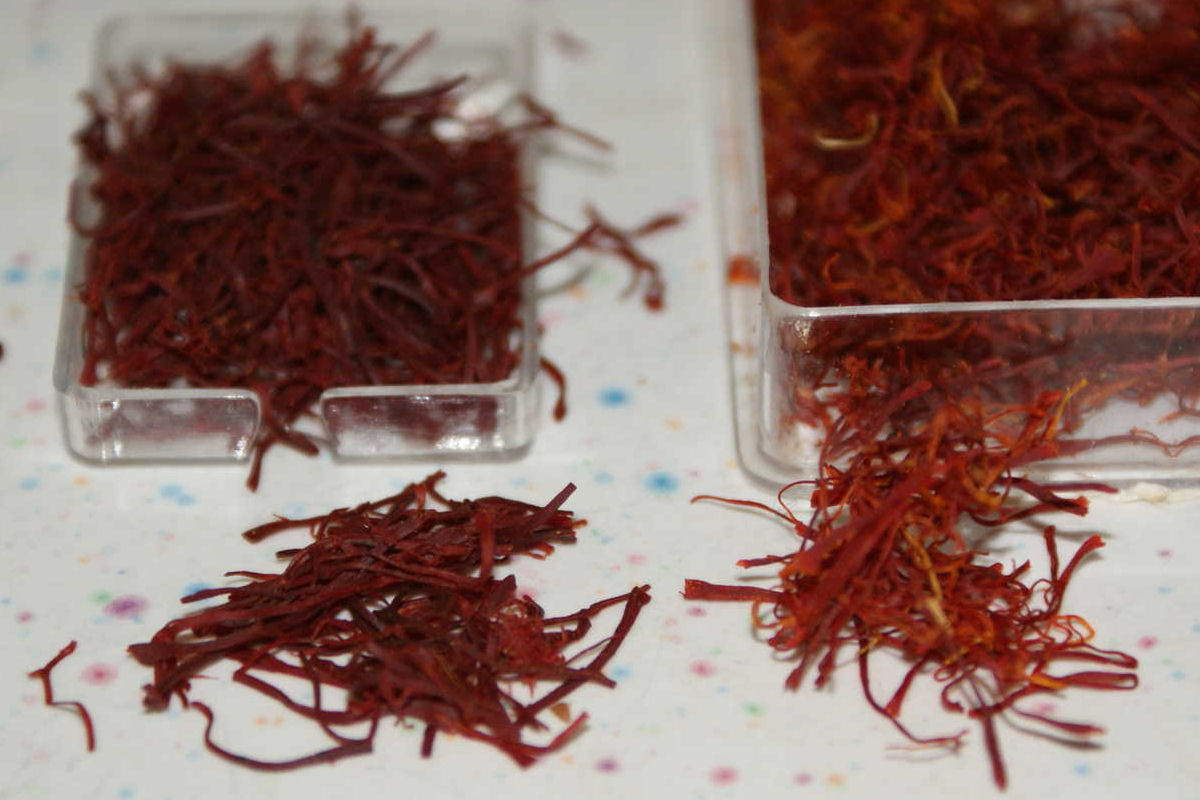
My Mum came up for a visit a couple of weekends ago,
and gifted me several small boxes of saffron that she brought back from her recent trip to Ladakh,
(The rest of my family visited me too - but they didn't bring me any saffron)
so I decided to use some of it up today making a quick dinner for myself and Flora,
who's come around to do her Day Skipper homework.
Or get it done :)
Unfortunately it turned out that the stuff Mum had carefully carried back with her was only a pale imitation of saffron. Or rather, it wasn't pale, but a slightly redder imitation, with none of saffron's lovely delicate flavour. Or aroma.
Pretty good imitation though - if you look closely at the photo.
Funnily enough, the food was still delicious, so the rest of the ingredients must have been good (and the saffron not made of poison!).
I fancied having another bash at my squid ink pasta, and it seemed appropriate to mix the squiddy pasta with something seafood so I popped in to my usual Musselburgh fishmonger at lunchtime hoping to find some nice crabs to make the sauce from, only to learn that local crabs are getting a bit skeletal at this time of year, and don't have a lot of meat. However he had plenty of big fat cooked crab claws from singapore (or somewhere less depressingly cold) so I decided to go with those, and make what is basically a spaghetti carbonara, except with crab instead of ham.
My fishmonger turned out to be right about the claws - there was plenty of very tasty meat in them, though a certain amount if fiddling is involved in getting it all out:
Take your tasty crab craw and start by levering open the knuckle (or elbow?) joint. If you're lucky you will pull out a nice chunk of delicious crab meat from the upper joint, otherwise you'll have to smash it open.
Then break open the claw itself - you can usually do this easily enough by laying it on a sturdy chopping block and striking it firmly with the flat side of a heavy meat cleaver. If you hit it too hard, or use the edge of the cleaver you'll end up shattering the shell into tiny shards and embedding them through the delicate meat that you've just pulped. But if you get it right you'll put just enough cracks into the claw to be able to peel off the shell and separate the flesh with your fingers or a small fork.
I didn't much fancy munching into unexpected clumps of saffron in my sauce, so I decided to crush the strands a little in a pestle and mortar then warm them up with the cream to leech out more of their colour and flavour.
But possibly all that isn't necessary - you could try having less homogenous colouring and just throw the saffron into the cold cream.
I was hoping to make a slightly richer and more squiddy version of the black pasta this time by using only egg yolks instead of whole eggs, but the dough just wouldn't hold together properly and I was ultimately forced to add some egg white.
The result didn't end up any more squiddy and I'm starting to think you're just not going to get a very strong ink flavour through black pasta simply due to the dilution involved.
Still, the taste was pretty good, I think having extra egg yolks did add a certain richness, though it's obviously trickier to get that when you're only making small quantities.
My dough (probably) ended up with the following proportions:
What with all this egg yolkery I ended up with a surfeit of egg whites, so under extreeeeeeeme pressure to provide Flora a dessert I whipped up a giant jam meringue that could really have done with another 6 hours of cooking.
After its first half-hour of baking, and an episode of Archer, we had bowls of the meringue with some of the leftover cream. It was still a bit raw, and distinctly "eggy" in the middle at this stage, but it was starting to show promise, so I stuck it back in the (turned off) oven for the rest of the night.
Unfortunately I didn't get to to taste (or photograph) the end result since my cute Landlady came back and snaffled up the lot, but apparently it really hit the spot ;) YUM.
Maybe I'll give it another shot sometime...
Or get it done :)
Unfortunately it turned out that the stuff Mum had carefully carried back with her was only a pale imitation of saffron. Or rather, it wasn't pale, but a slightly redder imitation, with none of saffron's lovely delicate flavour. Or aroma.
Pretty good imitation though - if you look closely at the photo.
Funnily enough, the food was still delicious, so the rest of the ingredients must have been good (and the saffron not made of poison!).
I fancied having another bash at my squid ink pasta, and it seemed appropriate to mix the squiddy pasta with something seafood so I popped in to my usual Musselburgh fishmonger at lunchtime hoping to find some nice crabs to make the sauce from, only to learn that local crabs are getting a bit skeletal at this time of year, and don't have a lot of meat. However he had plenty of big fat cooked crab claws from singapore (or somewhere less depressingly cold) so I decided to go with those, and make what is basically a spaghetti carbonara, except with crab instead of ham.
My fishmonger turned out to be right about the claws - there was plenty of very tasty meat in them, though a certain amount if fiddling is involved in getting it all out:
Take your tasty crab craw and start by levering open the knuckle (or elbow?) joint. If you're lucky you will pull out a nice chunk of delicious crab meat from the upper joint, otherwise you'll have to smash it open.
Then break open the claw itself - you can usually do this easily enough by laying it on a sturdy chopping block and striking it firmly with the flat side of a heavy meat cleaver. If you hit it too hard, or use the edge of the cleaver you'll end up shattering the shell into tiny shards and embedding them through the delicate meat that you've just pulped. But if you get it right you'll put just enough cracks into the claw to be able to peel off the shell and separate the flesh with your fingers or a small fork.
I didn't much fancy munching into unexpected clumps of saffron in my sauce, so I decided to crush the strands a little in a pestle and mortar then warm them up with the cream to leech out more of their colour and flavour.
But possibly all that isn't necessary - you could try having less homogenous colouring and just throw the saffron into the cold cream.
I was hoping to make a slightly richer and more squiddy version of the black pasta this time by using only egg yolks instead of whole eggs, but the dough just wouldn't hold together properly and I was ultimately forced to add some egg white.
The result didn't end up any more squiddy and I'm starting to think you're just not going to get a very strong ink flavour through black pasta simply due to the dilution involved.
Still, the taste was pretty good, I think having extra egg yolks did add a certain richness, though it's obviously trickier to get that when you're only making small quantities.
My dough (probably) ended up with the following proportions:
- 3 egg yolks
- white of around ½ egg
- 1 tablespoon olive oil
- 1 teaspoon salt
- 1 (5g) sachet squid ink
- around 5 oz semolina
What with all this egg yolkery I ended up with a surfeit of egg whites, so under extreeeeeeeme pressure to provide Flora a dessert I whipped up a giant jam meringue that could really have done with another 6 hours of cooking.
After its first half-hour of baking, and an episode of Archer, we had bowls of the meringue with some of the leftover cream. It was still a bit raw, and distinctly "eggy" in the middle at this stage, but it was starting to show promise, so I stuck it back in the (turned off) oven for the rest of the night.
Unfortunately I didn't get to to taste (or photograph) the end result since my cute Landlady came back and snaffled up the lot, but apparently it really hit the spot ;) YUM.
Maybe I'll give it another shot sometime...
Pasta Al Nero with Crab and Saffron Sauce
main fish pasta
It's probably obvious that my photography needs work - somehow the crab-smeared black pasta photos look rather unappetising.
Maybe a bowl of clean pasta with a dollop of crab in the middle would have looked more attractive?
Serves 2
Ingredients
- 1x4oz portion squid ink pasta, rolled and cut into linguine
- 200g shredded white crab meat, from around 8 claws
- 20g grated Parmesan, plus extra for topping
- ½ cup (8 tablespoons) double cream
- 1 teaspoon saffron strands
- 2 egg yolks
Crack open your crab claws and pluck out the meat into a bowl, then gently shred it with a fork.
Lightly crush the saffron strands in a pestle and mortar and add them to a small pot with the double cream and warm through gently, stirring occasionally, until the colour diffuses.
Allow to cool slightly before loosening up the egg yolks with a little of the cream and then blending into the pot. Add the crab meat.
Meanwhile cook the pasta (3-4 minutes) until cooked through, but al dente, drain, then return to the pot with the sauce and stir through.
The heat from the pasta should thicken the egg yolks making for a rich creamy sauce.
Serve
Lightly crush the saffron strands in a pestle and mortar and add them to a small pot with the double cream and warm through gently, stirring occasionally, until the colour diffuses.
Allow to cool slightly before loosening up the egg yolks with a little of the cream and then blending into the pot. Add the crab meat.
Meanwhile cook the pasta (3-4 minutes) until cooked through, but al dente, drain, then return to the pot with the sauce and stir through.
The heat from the pasta should thicken the egg yolks making for a rich creamy sauce.
Serve
Really nice stuff (even without the saffron)!
Make sure you serve it hot though - it's probably a good idea to warm the serving dishes since you're not pre-heating the sauce.
Make sure you serve it hot though - it's probably a good idea to warm the serving dishes since you're not pre-heating the sauce.
Giant Jam Meringue
dessert veg
Don't think about eating this after its first half-hour of cooking - it will still be eggy and underdone.
Serves 4
Ingredients
- 2 egg whites
- 160g caster sugar
- 2 tablespoons blueberry jam or whatever flavour you fancy
- cream
Preheat the oven to Gas Mark 7
Whip up the egg whites until they stiffen, then gradually beat in the sugar.
Line a shallow cake tin with parchment, smear a couple of tablespoons of jam into the centre, then heap over the meringue mixture.
Put in the oven for 10 minutes, or until the top is golden but not burnt, then turn down to the oven's lowest setting and leave for another 30 minutes.
Finally turn off the oven and leave the meringue to dry out overnight (say 6 hours)?
Serve with a dribble of cream.
Whip up the egg whites until they stiffen, then gradually beat in the sugar.
Line a shallow cake tin with parchment, smear a couple of tablespoons of jam into the centre, then heap over the meringue mixture.
Put in the oven for 10 minutes, or until the top is golden but not burnt, then turn down to the oven's lowest setting and leave for another 30 minutes.
Finally turn off the oven and leave the meringue to dry out overnight (say 6 hours)?
Serve with a dribble of cream.
I didn't actually get to try the very end product, but it looked like it was going to be good!
OMG Eggnog!
'Tis the season.
And that's official - now Starbucks have started selling their eggnog.
Mmmm. Eggnog!
Not only that, but they've re-opened their old café at Fort Kinnaird just to lure me over for coffee from my Musselburgh offices. EVERY. SINGLE. DAY.
It's like stepping back in time. To last year. Except that instead of being in a Borders bookshop, it's now in HMV/Waterstones. Bookshop.
Now I'll have to pass by those bloody bargain cookbook tables all over again. And I'd just got my credit card paid off too.
Of course, I wouldn't need to drive over there for coffee EVERY SINGLE DAY if Musselburgh weren't quite such a poxy shithole. And that's just our office.
So it's time to start planning the season's jollities - I've got:
And that's official - now Starbucks have started selling their eggnog.
Mmmm. Eggnog!
Not only that, but they've re-opened their old café at Fort Kinnaird just to lure me over for coffee from my Musselburgh offices. EVERY. SINGLE. DAY.
It's like stepping back in time. To last year. Except that instead of being in a Borders bookshop, it's now in HMV/Waterstones. Bookshop.
Now I'll have to pass by those bloody bargain cookbook tables all over again. And I'd just got my credit card paid off too.
Of course, I wouldn't need to drive over there for coffee EVERY SINGLE DAY if Musselburgh weren't quite such a poxy shithole. And that's just our office.
So it's time to start planning the season's jollities - I've got:
- Presents to buy
- Christmas cards to send
- A Christmas list to write
- Christmas cards to send
- I'd really like someone with some relevant skills (Bro - this means you) to get me some nice lights for photographing food.
- Mincemeat to make
-
And some nice mince pie recipes to sort out.
Ah well. Maybe next year :(
- A stuffing to decide on
-
For the Christmas goose. It's one of my duties.
I'm leaning towards something with quince or kumquats. My first thoughts were to do something with mango, but on reflection I don't really see that working.Well, I decided. But it's not a keeper. - A Christmas starter to design
-
I had the idea of making blue cheese soufflés by chilling a ball of cheese (perhaps blended with cream)
and sticking it in the middle of the soufflé mixture,
like a cheesy version of Ghirardelli's chocolate lava cakes
(as requested by Sophie while we made delicious
white chocolate crème brûlées
during my recent babysitting/cookery-lesson visit).
But then I realised that the last thing we really need at Christmas Dinner is another dish jealous of its oven time and temperature.
Better think again.
Something which can be made up well in advance and requires minimal cooking perhaps? - EGGNOG!
-
Maybe this year I'll get around to making some?
I already have a nice collection of recipes to work through.
Yep. Here's one we drank earlier.
Babysitting With Marshmallows
Well I selfishly volunteered for babysitting duties with the Eldorado girlies so that I still get to see them occasionally.
It's not their fault after all.
I've been wanting to try making some marshmallows after buying James Martin's Great British Winter Cookbook last winter and I figured it would be perfect for the girlies too, so I geared up all the ingredients and trucked on round after work.
It seemed surprisingly difficult to find liguid glucose when I first had the idea of trying this recipe, and I finally found some in Boots, heavily guarded behind the pharmacy counter. Then amusingly, when I was checking out the gleaming new giant Tesco which has just opened up near my office in Musselburgh any-fucking-town-in-the country I found little jars of liquid glucose by the dozen. Sitting right next to the leaf gelatin.
Which begs the question - what's the big deal with leaf gelatine anyway?
Of course as usual I managed to forget something.
It's not real Karl Cookery if you don't forget something.
That's my trademark. That and orange flavours. According to Jenny that's my trademark too. Though she kindly hasn't mentioned the forgetting something bit.
Usually I find the something just after I've served out the meal, but this time I forgot to bring the sugar thermometer before I even started.
And since Rachel doesn't have one (yet!) I had to guess the sugar temperature and I was probably a little on the low side.
Since it all worked out fine (though with rather more final whisking than advertised) maybe it isn't all that critical?
I was also a bit short of gelatin sheets, since they came only 12 to a pack, so I made up the difference with powder. According to the packets 12 gelatin leaves (20g) is sufficient for 3 pints of water, and one sachet (10g/4tsp) sufficient for 1 pint. So I added half a sachet of the powder too, and soaked the lot.
Obviously if you're making up a batch of marshmallows you need to have white ones and pink ones - all the best commercial bags do. So I thought I'd try some strawberry Nesquik as the flavouring agent.
Hugh Fearnley-Whatthehell uses beetroot in his, but I didn't think that was going to fly with my audience.
Also he doesn't use any glucose - so what does he know? (Does he know that you don't need glucose in your marshmallows?)
We made half white and half pink mallows, which worked out pretty well since we didn't have a large enough tray to set all of the mixture anyway.
We added (slightly more than) the advertised vanilla essence to the entire batch, poured half into one tray, then added the Nesquik and food colouring to the remaing mixture.
Usually my attempts to enlist the girlies enthusiasm for one of my cooking marathons meets with something approaching bitter disappointment (mine not theirs), but I think the girlies really enjoyed making up those pink and white fluffy pillows.
They did a fine job double-teaming the whisking (even dressing the part), there were lots of sticky sweet things to lick out and most importantly, it didn't actually take that long.
I think that's worth repeating. So I'll repeat it.
It didn't actually take that long.
You would think I would have learned that simple lesson after all my Eldorado Cookery - young girls having the attention span of the length of a pop song, but I still find it just about impossible to cook quickly, despite buying books with unconvincing titles like Fast Food in a desperate and usually futile attempt to get dinner on the table before midnight.
I'd be the worst MasterChef. Ever.
Waiting for the mallows to set is quite a challenge for girlies looking for a sugar high, but fortunately I brought along my awesome 10th Kingdom DVDs to keep them entertained.
They did a much better job than Sophie's homework.
All in all we must have done something right - the mallows were quite lovely, and I particularly liked the strawberry ones. Rachel must have thought so too, because she'd already eaten five before I'd even asked if she'd enjoyed her evening of freedom.
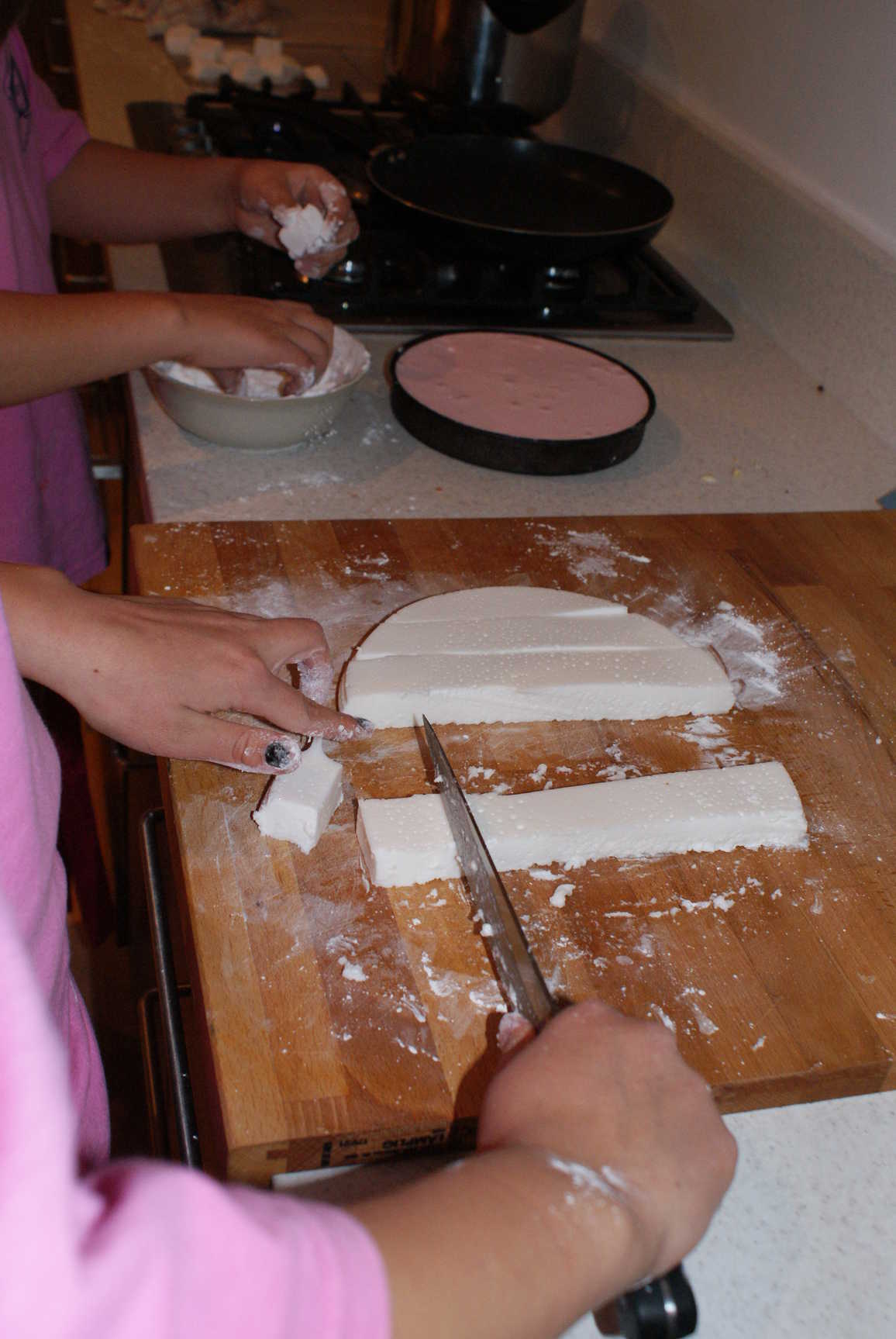
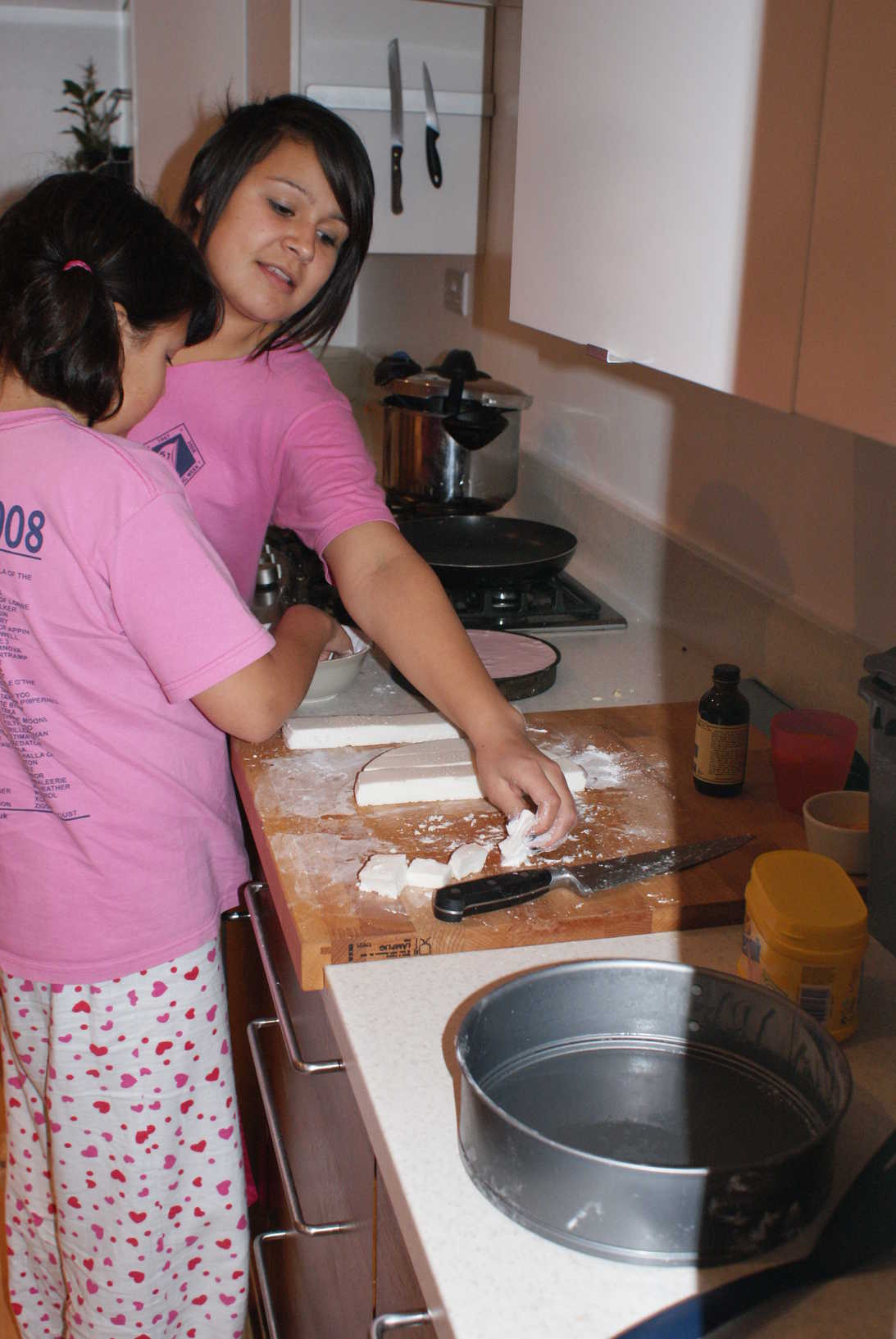
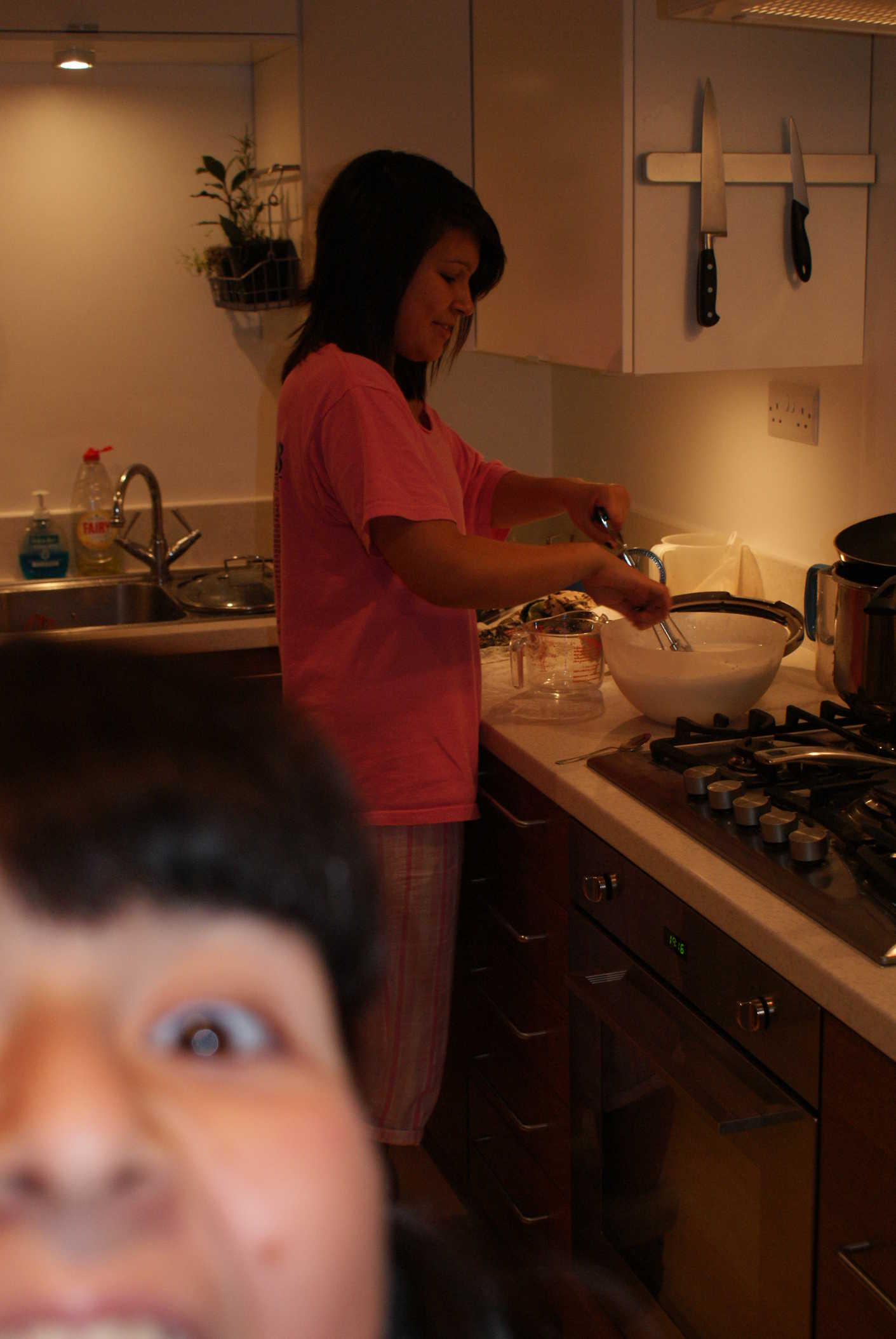 Go Team Eldorado Girlies!
Go Team Eldorado Girlies!
I've been wanting to try making some marshmallows after buying James Martin's Great British Winter Cookbook last winter and I figured it would be perfect for the girlies too, so I geared up all the ingredients and trucked on round after work.
It seemed surprisingly difficult to find liguid glucose when I first had the idea of trying this recipe, and I finally found some in Boots, heavily guarded behind the pharmacy counter. Then amusingly, when I was checking out the gleaming new giant Tesco which has just opened up near my office in Musselburgh any-fucking-town-in-the country I found little jars of liquid glucose by the dozen. Sitting right next to the leaf gelatin.
Which begs the question - what's the big deal with leaf gelatine anyway?
Apparently some cooks feel that leaf gelatin has no odour and makes a smoother clearer jelly.
I can see how the powder might end up being more grainy, but I disagree with them about the odour! - Ed
Of course as usual I managed to forget something.
It's not real Karl Cookery if you don't forget something.
That's my trademark. That and orange flavours. According to Jenny that's my trademark too. Though she kindly hasn't mentioned the forgetting something bit.
Usually I find the something just after I've served out the meal, but this time I forgot to bring the sugar thermometer before I even started.
And since Rachel doesn't have one (yet!) I had to guess the sugar temperature and I was probably a little on the low side.
Since it all worked out fine (though with rather more final whisking than advertised) maybe it isn't all that critical?
I was also a bit short of gelatin sheets, since they came only 12 to a pack, so I made up the difference with powder. According to the packets 12 gelatin leaves (20g) is sufficient for 3 pints of water, and one sachet (10g/4tsp) sufficient for 1 pint. So I added half a sachet of the powder too, and soaked the lot.
Obviously if you're making up a batch of marshmallows you need to have white ones and pink ones - all the best commercial bags do. So I thought I'd try some strawberry Nesquik as the flavouring agent.
Hugh Fearnley-Whatthehell uses beetroot in his, but I didn't think that was going to fly with my audience.
Also he doesn't use any glucose - so what does he know? (Does he know that you don't need glucose in your marshmallows?)
We made half white and half pink mallows, which worked out pretty well since we didn't have a large enough tray to set all of the mixture anyway.
We added (slightly more than) the advertised vanilla essence to the entire batch, poured half into one tray, then added the Nesquik and food colouring to the remaing mixture.
Usually my attempts to enlist the girlies enthusiasm for one of my cooking marathons meets with something approaching bitter disappointment (mine not theirs), but I think the girlies really enjoyed making up those pink and white fluffy pillows.
They did a fine job double-teaming the whisking (even dressing the part), there were lots of sticky sweet things to lick out and most importantly, it didn't actually take that long.
I think that's worth repeating. So I'll repeat it.
It didn't actually take that long.
You would think I would have learned that simple lesson after all my Eldorado Cookery - young girls having the attention span of the length of a pop song, but I still find it just about impossible to cook quickly, despite buying books with unconvincing titles like Fast Food in a desperate and usually futile attempt to get dinner on the table before midnight.
I'd be the worst MasterChef. Ever.
Waiting for the mallows to set is quite a challenge for girlies looking for a sugar high, but fortunately I brought along my awesome 10th Kingdom DVDs to keep them entertained.
They did a much better job than Sophie's homework.
All in all we must have done something right - the mallows were quite lovely, and I particularly liked the strawberry ones. Rachel must have thought so too, because she'd already eaten five before I'd even asked if she'd enjoyed her evening of freedom.



Marshmallows
sweet
Makes 1½lb
Ingredients
- 675g (1½lb) granulated sugar
- 1½ tablespoons liquid glucose
- 14 gelatin leaves
- 3 medium egg whites
- vegetable oil
- icing sugar
- cornflour
- 1½ teaspoons vanilla extract I used more like 2 teaspoons
- 12 teaspoons strawberry Nesquik and 2 teaspoons red food colouring optional
Put the sugar, glucose and 200ml (7fl oz) water in a heavy-based saucepan.
Add a sugar thermometer. Bring to the boil and cook until it reaches 127°C/260°F.
Meanwhile, soak the gelatine in 150ml (5fl oz) cold water and beat the egg whites until stiff. Lightly oil a shallow baking tray, about 30 x 20cm (12 x 8in). Dust it with sieved icing sugar and cornflour. I used a mixture of 60/40 icing sugar/cornflour.
When the syrup is up to temperature, carefully slide in the softened gelatine sheets and their soaking water. Hot gelatin doesn't smell all that appetising - a bit like boiling cow's feet really. The syrup will bubble up, so take care not to burn yourself. Pour the syrup into a metal jug.
Continue to beat the egg whites - preferably with an electric whisk - while pouring in the hot syrup from the jug. Do this very slowly, or the heat will cook the egg whites too much. The mixture will become shiny and start to thicken. Add the vanilla extract and continue whisking for about 5-10 minutes, Yeah? And the rest until the mixture is stiff and thick enough to to hold its shape on the whisk.
Meanwhile, soak the gelatine in 150ml (5fl oz) cold water and beat the egg whites until stiff. Lightly oil a shallow baking tray, about 30 x 20cm (12 x 8in). Dust it with sieved icing sugar and cornflour. I used a mixture of 60/40 icing sugar/cornflour.
When the syrup is up to temperature, carefully slide in the softened gelatine sheets and their soaking water. Hot gelatin doesn't smell all that appetising - a bit like boiling cow's feet really. The syrup will bubble up, so take care not to burn yourself. Pour the syrup into a metal jug.
Continue to beat the egg whites - preferably with an electric whisk - while pouring in the hot syrup from the jug. Do this very slowly, or the heat will cook the egg whites too much. The mixture will become shiny and start to thicken. Add the vanilla extract and continue whisking for about 5-10 minutes, Yeah? And the rest until the mixture is stiff and thick enough to to hold its shape on the whisk.
You can add the Nesquik and colouring too now if you like.
I used half the quantities of these above, pouring half the white mallow mixture off into a baking tray first, then mixing up the rest.
Spoon the mixture into a prepared baking tray, and smooth it with a wet palette knife if necessary. I didn't need to - the mixture was still pretty pourable. Possibly because I had to guess the sugar temperature since I didn't have a sugar thermometer. Leave for at least an hour to set.
Dust the work surface with more icing sugar and cornflour. Loosen the marshmallow around the sides of the tray with a palette knife, then turn it out on to the dusted surface. Cut into squares and roll in the sugar and cornflour. Leave to dry a little on a wire rack, then pack into an airtight box or jar.
Yumsk!
Bean Feast
In celebration of a flying visit by my vegetarian, gluten-intolerant, lactose-averse landlady Aline
we hosted a Bean Feast at our flat. Everything with beans!
I contributed my staple Fasolia and a new dish for me - Boston Baked Beans.
The beans came about as I was looking for ways to use up some nice fatty belly pork left over from our latest yacht trip down to the Farne Islands, where we spent a very comfortable night anchored off Lindisfarne holy island.
I attempted to combine a number of different source recipes from the fatuous (a Heston Blumenthal recipe mysteriously retired from their website - to which he seems to have forgotten to add the pork) through the modern (Hugh Fearnley-Whittingstallington's solid entry uses Black Treacle) to the Hillbilly traditional.
Tomatoes, fresh or in purée or ketchup form definitely mark the dividing line between Boston beans and the Heinz style baked bean varieties. I decided to try the tomato-free version.
Aline cooked up the remaining Feast entrants - and very nice some of them were too. Her Black Bean Brownies were surprisingly tasty, and I particularly liked the 4-bean salad. Aline - I didn't think it was too salty at all!
Slightly sadly, our bean feast was not particularly well attended, which means my lazy friends missed out on a delicious meal, but has the advantage of leaving me with a stuffed fridge.
Just a shame it's stuffed with beans.
menu
I contributed my staple Fasolia and a new dish for me - Boston Baked Beans.
The beans came about as I was looking for ways to use up some nice fatty belly pork left over from our latest yacht trip down to the Farne Islands, where we spent a very comfortable night anchored off Lindisfarne holy island.
I attempted to combine a number of different source recipes from the fatuous (a Heston Blumenthal recipe mysteriously retired from their website - to which he seems to have forgotten to add the pork) through the modern (Hugh Fearnley-Whittingstallington's solid entry uses Black Treacle) to the Hillbilly traditional.
Tomatoes, fresh or in purée or ketchup form definitely mark the dividing line between Boston beans and the Heinz style baked bean varieties. I decided to try the tomato-free version.
Aline cooked up the remaining Feast entrants - and very nice some of them were too. Her Black Bean Brownies were surprisingly tasty, and I particularly liked the 4-bean salad. Aline - I didn't think it was too salty at all!
Slightly sadly, our bean feast was not particularly well attended, which means my lazy friends missed out on a delicious meal, but has the advantage of leaving me with a stuffed fridge.
Just a shame it's stuffed with beans.
menu
Not Heinz. Boston.
Boston Baked Beans
side main
Serves 4
Ingredients
- 1lb/500g dried Haricot (Navy) beans
- 6 bay leaves
- 1lb/500g belly pork, cut into 2" pieces
- 3 tablespoons Demarara sugar I used 4, but I think that was too much
- 3 tablespoons blackstrap molasses
- 3 heaped teaspoons Colemans mustard powder
- 3 teaspoons Worcestershire Sauce
- 6 cloves garlic, crushed
- 4 cloves
- 10 shallots or small (pickling) onions, peeled
- ½ teaspoon salt
- grinding of pepper
Soak the beans overnight in plenty of water.
Preheat the oven to 150°C/300°F/Gas 2.
Drain and rinse the beans, put them in a pot with the bay leaves, cover with 2" water and bring to the boil. Skim off any foam which rises, then boil until the beans are soft, but not shedding their skins.
Transfer to an ovenproof dish (if the one you're using isn't).
Cut the belly pork into 2" cubes and add to the beans. Stir in the brown sugar, molasses, mustard powder and the Worcestershire Sauce.
Press the cloves into one of the shallots, then add them and the crushed garlic to the pot. Season with the pepper, add a little water if necessary to cover the beans, put the lid on the dish and bake in the oven until tender, stirring every hour or so and adding more water if necessary.
Uncover the beans and season with salt for the final hour of baking to evaporate off any excess moisture.
Preheat the oven to 150°C/300°F/Gas 2.
Drain and rinse the beans, put them in a pot with the bay leaves, cover with 2" water and bring to the boil. Skim off any foam which rises, then boil until the beans are soft, but not shedding their skins.
Transfer to an ovenproof dish (if the one you're using isn't).
Cut the belly pork into 2" cubes and add to the beans. Stir in the brown sugar, molasses, mustard powder and the Worcestershire Sauce.
Press the cloves into one of the shallots, then add them and the crushed garlic to the pot. Season with the pepper, add a little water if necessary to cover the beans, put the lid on the dish and bake in the oven until tender, stirring every hour or so and adding more water if necessary.
Uncover the beans and season with salt for the final hour of baking to evaporate off any excess moisture.
I really expected this would take only about 4 hours to bake, but my beans actually took more like 10.
That might have been because I didn't boil up the beans until they were completely softened to start with. Or it might be because I didn't completely cover the beans with water when I started them baking.
Remove the clove-studded shallot before serving.
That might have been because I didn't boil up the beans until they were completely softened to start with. Or it might be because I didn't completely cover the beans with water when I started them baking.
I didn't think these beans were particularly special, but I guess they're tasty enough.
Mine seemed a bit too sweet so I've suggested reducing the sugar content slightly.
Maybe I'll try out the more common tomato-based version sometime...
Mine seemed a bit too sweet so I've suggested reducing the sugar content slightly.
Maybe I'll try out the more common tomato-based version sometime...
Four Bean Salad
salad veg vegan
Serves 4
Ingredients
- About a 1lb mixture of cooked:
- Mung beans
- Blackeyed peas
- Chickpeas
- Black (turtle) beans
- Optional extras:
- chopped fresh chillies
- minced garlic
- finely chopped onion
Dressing:- Lots of Tamari soy sauce, say 50ml
- Balsamic vinegar, a splash
- A dash of hot sauce
- A great big bunch of fresh coriander, chopped
- Plenty of freshly squeezed lime juice
- olive oil
Cook your beans and drain them.
Stir in the dressing ingredients whilst the beans are still warm.
Adjust the quantities to suit your taste, it's nice with plenty of coriander though.
Adjust the quantities to suit your taste, it's nice with plenty of coriander though.
I didn't get to see quite what dressing proportions Aline used, but the result was very tasty.
Thai Bean Curry
oriental curry main veg vegan thai
Not sure what went into this concoction, except that there were a lot of foaming puréed yellow split peas
which looked very pretty and made a nice thickening agent.
Maybe Aline will enlighten us - watch this space...
Maybe Aline will enlighten us - watch this space...
Ingredients - Just a guess really
- Thai green curry paste
- fresh chillies
- fresh ginger
- button mushrooms
- aubergine
- can water chestnuts
- can bamboo shoots
- fresh kaffir lime leaves
- can coconut milk
- yellow split peas
- carrots
- frozen peas
- red pepper
- courgette
- fresh Thai basil leaves
- cashew nuts
Yep, here's Aline's description of her fine Thai dish.
I wasn't really watching what she did though, so we'll just have to take it on trust (I'm pretty sure she forgot the cashews!):
I wasn't really watching what she did though, so we'll just have to take it on trust (I'm pretty sure she forgot the cashews!):
As for the curry...
fry chillies and ginger, then add mushrooms (lots) to replace the meat :) then add few spoons of coconut milk + large spoon or two of that tasty Thai curry paste (I normally use 1 large spoon per can of coconut milk), more obviously if you like it spicy!
Leave the mushrooms to cook and soak up the paste etc, then add the cubed aubergine, canned/sliced chestnuts and bamboo shoots + fresh lime leaves with the remaining coconut milk, I used 2 cans here to feed the army!
Then left to cook for a while.
When all almost cooked, I added well cooked and pureed yellow split peas (I think half a bag it was, ca. 250g?), these are not necessary for a tasty Thai curry but they make the sauce a lot more substantial and nutritious!
Finally, I chucked in thinly sliced carrots (*), half a bag of frozen peas and in the very end - cos I like these crunchy - chunks of red pepper, sliced courgette + fresh sweet basil leaves (lots!)
...I think that was it!
(*)Please acknowledge my fantastic KP George :) There was a lot of veggies to chop
Thanks George!
Onion Bread
bread veg
Just regular bread really - only with onions.
See I've just got a new bread machine (nice cheap one from Lidl - seemed like a bargain though I'm a bit worried by how weedy the motor seems to be) and I didn't want to start off with anything too fancy first time out, but wanted a loaf with a bit more interest than plain old french so I just started it up the basic white recipe. Then whilst it did it's thing I gently caramelised a couple of onions in butter until they were nicely shrivelled and brown, squeezed them free of excess fat in kitchen paper, mixed them up with some flour, then added them to the bread when the machine paused for nuts or raisins or whatever.
The result was pretty good I thought. I was afraid it might end up too greasy with all the extra fat but it was OK.
I've seen a few bread machine onion recipes that add dried onions, or dried onion soup but I liked the natural approach better.
See I've just got a new bread machine (nice cheap one from Lidl - seemed like a bargain though I'm a bit worried by how weedy the motor seems to be) and I didn't want to start off with anything too fancy first time out, but wanted a loaf with a bit more interest than plain old french so I just started it up the basic white recipe. Then whilst it did it's thing I gently caramelised a couple of onions in butter until they were nicely shrivelled and brown, squeezed them free of excess fat in kitchen paper, mixed them up with some flour, then added them to the bread when the machine paused for nuts or raisins or whatever.
The result was pretty good I thought. I was afraid it might end up too greasy with all the extra fat but it was OK.
I've seen a few bread machine onion recipes that add dried onions, or dried onion soup but I liked the natural approach better.
Ingredients
- your usual white bread mixture
- onions
- butter
or AMAZING
Black Bean Brownies.
Black Bean Brownies
sweet veg
Aline made these for us, so I'm not sure exactly what recipe she used, but I think it went something like
this apparently lifted from
Ania Catalano's book Baking with Agave Nectar.
Plus Aline did conveniently buy a whole load of Agave nectar, so I figure that clinches it.
Plus Aline did conveniently buy a whole load of Agave nectar, so I figure that clinches it.
Makes 45 (2-inch) brownies.
Ingredients
- 4 ounces unsweetened chocolate
- 1 cup unsalted butter
- 2 cups soft-cooked black beans, drained well (hs: canned is fine)
- 1 cup walnuts, chopped
- 1 tablespoon vanilla extract
- ¼ cup (granulated) natural coffee substitute (or instant coffee, for gluten-sensitive)
- ¼ teaspoon sea salt
- 4 large eggs
- 1½ cups light agave nectar (or honey)
Preheat the oven to 325°F.
Line an 11- by 18-inch (rimmed) baking pan with parchment paper and lightly oil with canola oil spray.
Melt the chocolate and butter in a glass bowl in the microwave for 1½ to 2 minutes on high. Stir with a spoon to melt the chocolate completely. Place the beans, ½ cup of the walnuts, the vanilla extract, and a couple of spoonfuls of the melted chocolate mixture into the bowl of a food processor. Blend about 2 minutes, or until smooth. The batter should be thick and the beans smooth. Set aside.
In a large bowl, mix together the remaining ½ cup walnuts, remaining melted chocolate mixture, coffee substitute, and salt. Mix well and set aside.
In a separate bowl, with an electric mixer beat the eggs until light and creamy, about 1 minute. Add the agave nectar and beat well. Set aside.
Add the bean/chocolate mixture to the coffee/chocolate mixture. Stir until blended well.
Add the egg mixture, reserving about ½ cup. Mix well. Pour the batter into the prepared pan. Using an electric mixer, beat the remaining ½ cup egg mixture until light and fluffy. Drizzle over the brownie batter. Use a wooden toothpick to pull the egg mixture through the batter, creating a marbled effect. Bake for 30 to 40 minutes, until the brownies are set. Let cool in the pan completely before cutting into squares. (They will be soft until refrigerated.)
Melt the chocolate and butter in a glass bowl in the microwave for 1½ to 2 minutes on high. Stir with a spoon to melt the chocolate completely. Place the beans, ½ cup of the walnuts, the vanilla extract, and a couple of spoonfuls of the melted chocolate mixture into the bowl of a food processor. Blend about 2 minutes, or until smooth. The batter should be thick and the beans smooth. Set aside.
In a large bowl, mix together the remaining ½ cup walnuts, remaining melted chocolate mixture, coffee substitute, and salt. Mix well and set aside.
In a separate bowl, with an electric mixer beat the eggs until light and creamy, about 1 minute. Add the agave nectar and beat well. Set aside.
Add the bean/chocolate mixture to the coffee/chocolate mixture. Stir until blended well.
Add the egg mixture, reserving about ½ cup. Mix well. Pour the batter into the prepared pan. Using an electric mixer, beat the remaining ½ cup egg mixture until light and fluffy. Drizzle over the brownie batter. Use a wooden toothpick to pull the egg mixture through the batter, creating a marbled effect. Bake for 30 to 40 minutes, until the brownies are set. Let cool in the pan completely before cutting into squares. (They will be soft until refrigerated.)
Tasty too.
Leftover Leftover Liquorice Day
Now I have leftovers from the meal I made yesterday
to use up the leftovers from my
Liquorice Dinner.
So I thought I'd use a spare lemon with the spare squid ink pasta
to try Jamie Oliver's very simple
lemon linguine.
Naturally, being a pretentious arse Jamie insists you should use Sicilian lemons, which reputedly being less acidic, might explain some taste differences, but I thought the recipe was pretty much rubbish. The balance of flavours are all wrong - far too much lemon and not nearly enough olive oil, however a bit of adjustment gives you something that's not too unpalatable. I'm just not entirely sure it's significantly better than simply leaving out the lemon completely.
You could try adding some dried red chillies.
I'm slightly dubious about garlic but you could try that too.
Naturally, being a pretentious arse Jamie insists you should use Sicilian lemons, which reputedly being less acidic, might explain some taste differences, but I thought the recipe was pretty much rubbish. The balance of flavours are all wrong - far too much lemon and not nearly enough olive oil, however a bit of adjustment gives you something that's not too unpalatable. I'm just not entirely sure it's significantly better than simply leaving out the lemon completely.
You could try adding some dried red chillies.
I'm slightly dubious about garlic but you could try that too.
Lemon Linguine
main pasta
You don't have to use squid ink pasta with this. In fact. Probably you shouldn't.
Serves 4
Ingredients
- 1 lb/500g/16 nests linguine
- grated peel ½-1 lemon
- juice 1 lemon
- 6 tablespoons olive oil
- 2 oz/60g grated parmesan
- handful torn basil leaves
- handful rocket
- salt and pepper
Whilst the pasta is cooking, beat the lemon juice and rind with the olive oil
around twice oil to juice and add the parmesan.
Season.
Strain the pasta and add it back to the hot pan together with the sauce and give it a good stir.
The heat will melt the cheese and give the pasta a smooth coating, after which you can allow it to cool slightly before mixing in the torn basil leaves and the rocket.
Strain the pasta and add it back to the hot pan together with the sauce and give it a good stir.
The heat will melt the cheese and give the pasta a smooth coating, after which you can allow it to cool slightly before mixing in the torn basil leaves and the rocket.
Some possible extras:
- a grating of nutmeg
- dried red chilli flakes
- minced fresh green chilli (quite good!)
- minced garlic (dubious?)
- chopped black olives
- mint/chives or any other herbs you fancy
- no lemons!
Actually I'm starting to like it now.
My proportions above are pretty good!
Leftover Liquorice Day
Ah, the joy of living off dinner party leftovers.
Today I used up some of the Liquorice and Blackberry sauce and the Braised Cabbage from my last meal. I happened to pop into Clark Bros - my Musselburgh fishmongers - for a lunchtime kipper today, and was surprised to discover that they'd (finally) managed to find an enormous stock of squid ink, so I had another go at my previously disappointing Pasta Al Nero.
I'd also been thinking of trying out the Liquorice sauce with something other than pheasant - duck or venison maybe, and the lo the gods were obviously smiling on me this week: after almost giving up on Asda's pitiful meat cabinets (and not having found the time to get to a real butcher what with my cylinder heads filling up with water and all) I found a single plastic pack of edible-looking duck breasts last night, so I grabbed them quick.
This time, when I freshened up the sauce with some extra blackberries I didn't bother with any red wine - just a good dose of Creme de Cassis, and a glug of port to simmer up another half dozen blackberries or so. Finished off with a couple of teaspoons of liquorice essence.
Today I used up some of the Liquorice and Blackberry sauce and the Braised Cabbage from my last meal. I happened to pop into Clark Bros - my Musselburgh fishmongers - for a lunchtime kipper today, and was surprised to discover that they'd (finally) managed to find an enormous stock of squid ink, so I had another go at my previously disappointing Pasta Al Nero.
I'd also been thinking of trying out the Liquorice sauce with something other than pheasant - duck or venison maybe, and the lo the gods were obviously smiling on me this week: after almost giving up on Asda's pitiful meat cabinets (and not having found the time to get to a real butcher what with my cylinder heads filling up with water and all) I found a single plastic pack of edible-looking duck breasts last night, so I grabbed them quick.
This time, when I freshened up the sauce with some extra blackberries I didn't bother with any red wine - just a good dose of Creme de Cassis, and a glug of port to simmer up another half dozen blackberries or so. Finished off with a couple of teaspoons of liquorice essence.
Pan-Fried Duck Breasts with Blackberry Liquorice Sauce
main fowl
Served on a bed of Tagliatelli Al Nero Di Seppia, with a side saddle of Braised Red Cabbage.
Yes - you're right, they don't really work together - delicious though the cabbage undoubtedly is, it doesn't go with the black pasta, and the squid inky flavour is too subtle and delicate for the robust sauce. It might work better with a stronger flavour (more squid ink perhaps?) but I'm not convinced that's physically possible. Something to try next time.
I think something like a nutty couscous, butternut squash purée or nutty parsnip purée might work, and you could substitute spinach, or swiss chard for the red cabbage. Even the samphire from my original dinner.
Yes - you're right, they don't really work together - delicious though the cabbage undoubtedly is, it doesn't go with the black pasta, and the squid inky flavour is too subtle and delicate for the robust sauce. It might work better with a stronger flavour (more squid ink perhaps?) but I'm not convinced that's physically possible. Something to try next time.
I think something like a nutty couscous, butternut squash purée or nutty parsnip purée might work, and you could substitute spinach, or swiss chard for the red cabbage. Even the samphire from my original dinner.
Serves ME!
Ingredients
- duck breasts
- Blackberry Liquorice Sauce
Preheat the oven to 400°F/200°C/Gas Mark 6.
Put in a heavy baking tray if you don't have a skillet that will go straight into the oven from the hob.
Bubble up some blackberries in port and Creme de Cassis (and maybe a basil leaf or two) for the sauce in a small pot whilst you get on with the duck.
First cut away any sinews from the fleshy side of the breasts - these will tighten up on cooking and deform the fillets.
Deeply score the duck skin and fat in a nice diagonal criss-cross pattern without cutting into the flesh.
Sprinkle salt (and pepper if you like) into the skin and the flesh.
Get a heavy frying pan or cast iron skillet nice and hot, and slap the duck breasts into it, skin side down. You can lubricate the pan with a little bacon fat or olive oil if you like, but it's not necessary. Let the breasts sizzle away, and cook them over a medium heat until the fat has rendered nicely away, the skin is crispy mahogany, and the flesh has coloured about half the way through the breast. This should take around 5 minutes. Spots of blood and juice will be oozing out of the upper side.
Now pour away the fat from the skillet and stick it straight into the oven without turning the breasts. Cook in the oven for about 10 more minutes until the breasts are just cooked all the way through.
Put in a heavy baking tray if you don't have a skillet that will go straight into the oven from the hob.
Bubble up some blackberries in port and Creme de Cassis (and maybe a basil leaf or two) for the sauce in a small pot whilst you get on with the duck.
First cut away any sinews from the fleshy side of the breasts - these will tighten up on cooking and deform the fillets.
Deeply score the duck skin and fat in a nice diagonal criss-cross pattern without cutting into the flesh.
Sprinkle salt (and pepper if you like) into the skin and the flesh.
Get a heavy frying pan or cast iron skillet nice and hot, and slap the duck breasts into it, skin side down. You can lubricate the pan with a little bacon fat or olive oil if you like, but it's not necessary. Let the breasts sizzle away, and cook them over a medium heat until the fat has rendered nicely away, the skin is crispy mahogany, and the flesh has coloured about half the way through the breast. This should take around 5 minutes. Spots of blood and juice will be oozing out of the upper side.
Now pour away the fat from the skillet and stick it straight into the oven without turning the breasts. Cook in the oven for about 10 more minutes until the breasts are just cooked all the way through.
If you want to brown the duck breasts all over just flip them over in the frying pan and briefly fry the other side.
If you don't have a skillet that will go in the oven, just transfer the breasts, skin-side down, to a heated oven tray instead.
If you like totally rare duck, and you are happy living a little dangerously, then skip the oven completely and just flip the breasts for a couple of minutes, then set aside to rest.
If you like totally rare duck, and you are happy living a little dangerously, then skip the oven completely and just flip the breasts for a couple of minutes, then set aside to rest.
They will look puffed up and sealed on the top side, which will just have turned from pink to grey. It's best to use a meat thermometer to check this if you have one - make sure the centre of the breasts have reached 125°F.
Set the breasts aside to rest for 5 minutes while you finish off the sauce - push it through a fine sieve, and dose with liquorice essence. Season with salt and add more Creme de Cassis if necessary.
Slice the breasts at an angle into nice ½" pieces (it's easier with the skin down), and serve them arranged nicely on a puddle of sauce, or with the sauce drizzled over.
Scatter a few drops of the pure liquorice essence over the top to finish.
I have to say, the breasts and sauce were luvverly.
Better than the pheasant from my previous effort. Though I think that was the pheasant's fault rather than the overall concept.
Better than the pheasant from my previous effort. Though I think that was the pheasant's fault rather than the overall concept.
The Last Supper
Well, it's official. My three-year relationship with the Eldoradoes has come to an end.
Not with a bang but a whimper.
And an ironically nice dinner at the ever-reliable Wedgewood. (If you are looking to break up with your girlfriend I highly recommend their updated version of couscous-encrusted lamb, which is now rolled in crushed fennel and what might be mustard seeds. Very tasty.)
The plan was to spend a pleasant evening in the company of Doctor Jenny and boy, taking in a couple of shows at the Fringe and rounding off with good food courtesy of what is fast becoming a favourite standby.
Well, the food was as delightful as ever, but the comedy wasn't funny, my girlfriend unusually surly, and the tension between us only grew over the course of the evening, developing into full-grown discomfort by the time we were wandering aimlessly around town looking for a late-night cabaret.
When you can barely hold a civilised conversation with your girlfriend, I guess it's just time to call it a day.
Those poor Eldorado girls, we always seem to break up just before one or other of their birthdays, so this time I took pity on Georgina and followed through with her Lego™ CrocoSharkAsaur kit.
Which she seems to love.

Gonna miss you guys.

And an ironically nice dinner at the ever-reliable Wedgewood. (If you are looking to break up with your girlfriend I highly recommend their updated version of couscous-encrusted lamb, which is now rolled in crushed fennel and what might be mustard seeds. Very tasty.)
The plan was to spend a pleasant evening in the company of Doctor Jenny and boy, taking in a couple of shows at the Fringe and rounding off with good food courtesy of what is fast becoming a favourite standby.
Well, the food was as delightful as ever, but the comedy wasn't funny, my girlfriend unusually surly, and the tension between us only grew over the course of the evening, developing into full-grown discomfort by the time we were wandering aimlessly around town looking for a late-night cabaret.
When you can barely hold a civilised conversation with your girlfriend, I guess it's just time to call it a day.
Those poor Eldorado girls, we always seem to break up just before one or other of their birthdays, so this time I took pity on Georgina and followed through with her Lego™ CrocoSharkAsaur kit.
Which she seems to love.

Gonna miss you guys.
Worcestershire Sauce Day
Rachel told me of her unsatisfactory attempts to create a Worcestershire sauce-based chicken dish
something along the lines of an ersatz gumbo I believe.
Apparently it turned out little different from a Dolmio pasta sauce, so I thought I'd have a go myself.
I decided that rather than try a stew type approach I'd take my cue from Michael Smith's recipe for Nell Gwynn's Breasts and stuff chicken fillets with something Worcestershire saucy, then have a cheesy, but Worcestershire, dressing to go with them.
And a nice bean salad with a Worcestershire dressing.
Everything Worcestershire! (Well, OK, I didn't have a Worcestershire pudding. I think that might just have made everyone sick!)
I went for a mushroom Duxelles stuffing flavoured with the Worcestershire, which was delicious even by itself. It gave the breasts a fine dark centre like the skin of a dusky maiden, say Nell Carter (OK, my first choice would have been Halle Berry too, but I've got a theme going on here dammit), and tasted pretty fine too.
In keeping with my plans to marry monkfish with all the blue cheeses of the world I took the opportunity to fry up some monkfish along with my dusky breasts for moral support. Gorgeous pink-capped mounds of firm alabaster flesh, I wanted to call them Rachel's Breasts, but she wouldn't let me. So Eskimo Nell's they are.
The juices from the chicken roasting dish have a nice Worcestershire flavour, which makes a good dressing for the otherwise slightly dry crispy fried noodles, and a pickled cherry salad works hard at cutting through some of the salty richness of the rest of the meal.
Just a word of warning - though today may be Worcestershire, tomorrow will be Garlic.
This meal even got a full five star rating from Georgina, thumbs up and everything - though that might have something to do with the fact that she had special chicken, with a special sauce, and a special salad. And carrots. So not this meal at all then.
menu
Apparently it turned out little different from a Dolmio pasta sauce, so I thought I'd have a go myself.
I decided that rather than try a stew type approach I'd take my cue from Michael Smith's recipe for Nell Gwynn's Breasts and stuff chicken fillets with something Worcestershire saucy, then have a cheesy, but Worcestershire, dressing to go with them.
And a nice bean salad with a Worcestershire dressing.
Everything Worcestershire! (Well, OK, I didn't have a Worcestershire pudding. I think that might just have made everyone sick!)
I went for a mushroom Duxelles stuffing flavoured with the Worcestershire, which was delicious even by itself. It gave the breasts a fine dark centre like the skin of a dusky maiden, say Nell Carter (OK, my first choice would have been Halle Berry too, but I've got a theme going on here dammit), and tasted pretty fine too.
In keeping with my plans to marry monkfish with all the blue cheeses of the world I took the opportunity to fry up some monkfish along with my dusky breasts for moral support. Gorgeous pink-capped mounds of firm alabaster flesh, I wanted to call them Rachel's Breasts, but she wouldn't let me. So Eskimo Nell's they are.
The juices from the chicken roasting dish have a nice Worcestershire flavour, which makes a good dressing for the otherwise slightly dry crispy fried noodles, and a pickled cherry salad works hard at cutting through some of the salty richness of the rest of the meal.
Just a word of warning - though today may be Worcestershire, tomorrow will be Garlic.
This meal even got a full five star rating from Georgina, thumbs up and everything - though that might have something to do with the fact that she had special chicken, with a special sauce, and a special salad. And carrots. So not this meal at all then.
menu
Nell Carter's Breasts
Eskimo Nell's Breasts
Little Nell's Breasts
Crispy Fried Noodles
Pickled Cherry Salad
Green Bean Salad
Breasts with a rich, dark centre.
Eskimo Nell's Breasts
Plump white morsels.
Little Nell's Breasts
Virgin flesh.
Crispy Fried Noodles
A little something to soak up the juices.
Pickled Cherry Salad
A tangy salad to relieve the richness of all that breast meat.
Green Bean Salad
For something a little different.
Green Bean Salad
salad
I suppose the idea here came from St John Restaurant's lovely
Green Beans, Shallots, Garlic and Anchovies
Serves 4
Ingredients
- 200g fine beans, trimmed
- peas, podded, about the same amount
- 4 cloves garlic, finely sliced
- spring onions and broad beans might be nice
- olive oil
- a few drops white wine vinegar
Dressing:- 1 50g tin anchovies, crushed
- 3 cloves garlic, crushed
- juice of 1 lime
- 2 teaspoons capers, crushed
- 1 teaspoon Worcestershire sauce
- ground mixed peppercorns
- olive oil
Trim the beans and slice them into 1" pieces. Pod the peas.
Blanch the vegetables: Bring a pot of water to the boil, and throw in the beans, when it boils up again, add the peas, reboil and simmer for about 20 seconds, drain and rinse the vegetables quickly in cold water.
Drain and dry thoroughly, then add the garlic slices, coat in olive oil and drizzle with white wine vinegar.
Set aside to marinate in the fridge for an hour before serving.
Make the dressing:
Grind the anchovies, then garlic cloves and then capers together in a mortar. Since you won't want to add any extra salt, use peppercorns to provide a little grit for the grinding process. Add enough liquid to get a good paste, then the rest of the lime juice and Worcestershire sauce. Shake up with about the same quantity of olive oil in a jam jar.
Blanch the vegetables: Bring a pot of water to the boil, and throw in the beans, when it boils up again, add the peas, reboil and simmer for about 20 seconds, drain and rinse the vegetables quickly in cold water.
Drain and dry thoroughly, then add the garlic slices, coat in olive oil and drizzle with white wine vinegar.
Set aside to marinate in the fridge for an hour before serving.
Make the dressing:
Grind the anchovies, then garlic cloves and then capers together in a mortar. Since you won't want to add any extra salt, use peppercorns to provide a little grit for the grinding process. Add enough liquid to get a good paste, then the rest of the lime juice and Worcestershire sauce. Shake up with about the same quantity of olive oil in a jam jar.
This is a really tasty salad, especially with the anchovy dressing, though you can leave that off if you like,
but go pretty easy with it, a thin coating is more than enough
and you might want to cut back on the garlic slices too if you're having both dressings. It can get pretty garlicky. Especially the day after.
The blanching takes any slightly bitter edge off the vegetables, though maybe your peas won't need it.
Some (spring) onions or podded, blanched broad beans might be nice also, Yes they're fine - blanch the broad beans before adding the green ones. and I'm sure you could throw in any herbs you fancied - rosemary/thyme/oregano maybe coriander.
You can add feta cheese and other vegetables, like red pepper, grated carrots, torn lettuce leaves and the rest, and it's still nice with the dressing and all.
The blanching takes any slightly bitter edge off the vegetables, though maybe your peas won't need it.
Some (spring) onions or podded, blanched broad beans might be nice also, Yes they're fine - blanch the broad beans before adding the green ones. and I'm sure you could throw in any herbs you fancied - rosemary/thyme/oregano maybe coriander.
You can add feta cheese and other vegetables, like red pepper, grated carrots, torn lettuce leaves and the rest, and it's still nice with the dressing and all.
Pickled Cherry Salad
salad raw veg vegan
Serves 4
Ingredients
- dozen cherries, halved, stoned
- half dozen button mushrooms, quartered
- 1 small red onion, halved, thinly sliced
- rocket, lamb's lettuce and watercress salad leaves
Dressing:- white wine vinegar
- balsamic vinegar
- walnut oil
- salt and ground mixed peppercorns
Halve the cherries, remove the stones and leave to marinate overnight in a covering of white wine vinegar and a drizzle of balsamic.
Next day, quarter the button mushrooms (or so - depending on their size) and mix them up with the cherries and a generous dollop of walnut oil.
Season, add a finely sliced red onion and set aside to mature for an hour or so.
When you're ready to serve, combine the cherry mixture with your salad leaves in a large bowl.
When you're ready to serve, combine the cherry mixture with your salad leaves in a large bowl.
Ok, the cherries don't take on all that much pickling, but I still thought it was quite a refreshing salad, good with strong or rich flavours.
Which is exactly what we had.
You could probably pickle the cherries for longer, or simmer them up with the vinegar, but then they'd probably go mushy unless you started with pretty hard or sour ones.
You could probably pickle the cherries for longer, or simmer them up with the vinegar, but then they'd probably go mushy unless you started with pretty hard or sour ones.
Somehow I imagined Nell Carter's breasts would be bigger...
Nell Carter's Breasts with Blue Cheese Sauce
main fowl cheese
Serves 4
Ingredients
- 4 skinless chicken breast fillets
- 300g smoked bacon slices
- 200g shallots, minced
- 200g mini portabella mushrooms, minced
- generous knob butter
- glass white wine
- 3 Tablespoons Worcestershire sauce (or so)
Sauce:- 200g Roquefort (or other tasty blue cheese)
- 4 Tablespoons crème fraîche or sour cream
- 1 Tablespoon Dijon mustard
- 1 Tablespoon Worcestershire sauce
- 1 Tablspoon tomato purée
- ½ teaspoon tsp paprika
- good pinch of ground cayenne unless you're cooking for the hyper spiceogenic
- Freshly ground pepper
Sweat the finely minced shallots in the butter until softened,
then add the finely minced mushrooms and sweat until they lose their moisture and begin to hold together with the oil separating off.
Add the glass of wine, reduce the mixture back down, then add the Worcestershire sauce and reduce again. Add sauce to your taste - the vinegary edge softens as the mixture cooks.
Lay each chicken fillet on a chopping board, cover with a sheet of cling film and use a rolling pin to hammer them thin and flat.
Coat each flattened fillet with the duxelles mixture, then roll up and then wrap bacon slices around the breasts in a spiral. If you pull on the slices a little as you go they should stick to the chicken well enough without resorting to cocktail sticks or string. Though you can if you need to. It helps if the bacon slices are nice and wide, not cut too thickly and are reasonably stretchy.
Chilling the chicken rolls before you cook them will help them to stay together, but once the bacon crisps up it should stay put alright.
Quickly brown the wrapped chicken breasts in a generous knob of butter in a heavy frying pan, carefully turning to cover all sides. Then bake in a 180°C oven for 20 minutes or so until cooked through (200°C really is too hot for a fan-assisted oven), but keep an eye on them in case they start to burn.
Meanwhile, make the blue cheese sauce by heating all the ingredients gently in a pan whilst stirring them with a wooden spoon.
Add the glass of wine, reduce the mixture back down, then add the Worcestershire sauce and reduce again. Add sauce to your taste - the vinegary edge softens as the mixture cooks.
Lay each chicken fillet on a chopping board, cover with a sheet of cling film and use a rolling pin to hammer them thin and flat.
Coat each flattened fillet with the duxelles mixture, then roll up and then wrap bacon slices around the breasts in a spiral. If you pull on the slices a little as you go they should stick to the chicken well enough without resorting to cocktail sticks or string. Though you can if you need to. It helps if the bacon slices are nice and wide, not cut too thickly and are reasonably stretchy.
Chilling the chicken rolls before you cook them will help them to stay together, but once the bacon crisps up it should stay put alright.
Quickly brown the wrapped chicken breasts in a generous knob of butter in a heavy frying pan, carefully turning to cover all sides. Then bake in a 180°C oven for 20 minutes or so until cooked through (200°C really is too hot for a fan-assisted oven), but keep an eye on them in case they start to burn.
Meanwhile, make the blue cheese sauce by heating all the ingredients gently in a pan whilst stirring them with a wooden spoon.
Pretty tasty stuff, the sauce is strong though. Maybe a touch less cheese.
Eskimo Nell's Breasts
main fish
They're deliciously pink-skinned firm white pillows - I call them Eskimo Nell's Breasts.
I was going to call them Rachel's Breasts, but she wouldn't let me.
I was going to call them Rachel's Breasts, but she wouldn't let me.
Serves 2
Ingredients
- A nice monkfish fillet
- 200g smoked bacon slices
Filling:- anchovies
- garlic cloves
- lime juice
- Worcestershire sauce
Make the filling by grinding up the anchovies with a couple of garlic cloves in a pestle and mortar.
Moisten the mixture with Worcestershire sauce and a squeeze of lime.
Cut the monkfish fillets into reasonably sized chunks. The plan is to get some filling into them before wrapping them up in bacon as for Halle Berry's Breasts, and the best way to do that is to cut the monkfish into quarter fillets then join them back together with paste in between. You could try lightly flattening them so they'll roll up, but that will probably just make them fall apart.
Once you've got them wrapped in the bacon, fry them in the pan after the chicken and put them uncovered lower down the same oven.
Serve with the same blue cheese sauce.
Cut the monkfish fillets into reasonably sized chunks. The plan is to get some filling into them before wrapping them up in bacon as for Halle Berry's Breasts, and the best way to do that is to cut the monkfish into quarter fillets then join them back together with paste in between. You could try lightly flattening them so they'll roll up, but that will probably just make them fall apart.
Once you've got them wrapped in the bacon, fry them in the pan after the chicken and put them uncovered lower down the same oven.
Serve with the same blue cheese sauce.
Mainly I fancied trying out the blue cheese sauce with these monfish fillets.
It's a pretty good combo, especially with the bacon, though the sauce is a bit overpowering.
Maybe it could be made a bit less, well, blue? Less cheese or a bit of yoghurt or cream?
Also, it's all a bit salty - might work better with unsmoked bacon.
Could probably have done without the filling too, to be honest.
Could probably have done without the filling too, to be honest.
Untouched by mushrooms. Or blue cheese.
Little Nell's Breasts
main fowl cheese
For those not up to the challenge of the full-strength mounds above.
Serves 1 sensitive philistine
Ingredients
- 1 skinless chicken breast fillet
- 3 unsmoked bacon slices
- double gloucester, sliced
Sauce:- 1 tablespoon flour
- 1 tablespoon butter
- 1 level tablespoon tomato purée
- 1 scant cup milk
- double gloucester, grated
- 1 tablespoon Worcestershire sauce, or to taste
Flatten the chicken breast, cover with thin slices of the double gloucester, roll it up and wrap it in bacon.
Fry and bake with the other magnificent breasts above.
Make a regular cheese sauce - fry the flour in butter until it starts to colour. You can use any spare butter left over from frying the chicken breasts here too. Add the tomato purée fry briefly then gradually whisk in a little milk at a time until you've got a nice sauce consistency add your grated orange cheese and Worcestershire sauce so it tastes nice. But not too scary.
Serve Little Nell's breasts with the cheesy custard and bask in the approbation.
Fry and bake with the other magnificent breasts above.
Make a regular cheese sauce - fry the flour in butter until it starts to colour. You can use any spare butter left over from frying the chicken breasts here too. Add the tomato purée fry briefly then gradually whisk in a little milk at a time until you've got a nice sauce consistency add your grated orange cheese and Worcestershire sauce so it tastes nice. But not too scary.
Serve Little Nell's breasts with the cheesy custard and bask in the approbation.
A fine alternative to anything with mushrooms or blue cheese in it.
Georgina was very appreciative, and favourably compared the cheese sauce to her Mum's macaroni cheese.
Apparently she is also prepared to tolerate orange cheese sauce with mustard.
Crispy Fried Noodles
side staple veg
Serves 4
Ingredients
- pack fresh egg noodles
- 4 spring onions, sliced diagonally
- groundnut oil
- sesame oil, to finish
Mix up the noodles with spring onions diagonally sliced about ⅛" thick.
Get a wok nice and hot, add a layer of peanut oil, then add the noodles, shake them to warm through, then turn the heat down low and leave the noodles to cook until they crisp nicely on the lower side.
Turn the noodle cake by sliding it off onto a plate, inverting the wok over the plate then turning the wok around again. Brown the other side until crispy.
Finish off the noodles with a ladleful of stock if they're looking a bit dry and a drizzle of sesame oil.
You can tip them into a warmed serving dish to keep warm until needed.
Get a wok nice and hot, add a layer of peanut oil, then add the noodles, shake them to warm through, then turn the heat down low and leave the noodles to cook until they crisp nicely on the lower side.
Turn the noodle cake by sliding it off onto a plate, inverting the wok over the plate then turning the wok around again. Brown the other side until crispy.
Finish off the noodles with a ladleful of stock if they're looking a bit dry and a drizzle of sesame oil.
You can tip them into a warmed serving dish to keep warm until needed.
You get quite a nice noodle cake out of this, crispy on the outside and moist in the middle,
but it sort of sticks together a bit too much and it definitely needs a bit of juice to get it going.
Fortunately all those luscious breasts leak quite a bit.
Fortunately all those luscious breasts leak quite a bit.
IKEA Weekend
On my regular visit to my local fishmonger to inquire after sachets of squid ink I ended up settling for a brace of sea bass instead.
These formed the basis for a couple of tasty meals over a weekend of IKEA cupboard-building.
It was observed, quite fairly I thought, that the first dinner - Pan-Fried Sea Bass with Beetroot Rösti, Pak Choy and Lemon Grass Sauce took an absurd length of time to prepare. Ten hours does seem excessive. In my defence - this included several hours of sauce reduction, some messy fish cleaning and a great deal of rösti experimentation. I'm sure you could knock this out in a mere 6 hours or so!
Fortunately for the sanity of my audience, the second Sea Bassy meal with Apple-Mustard sauce and stuffed courgettes took only minutes.
About a hundred or so.
These formed the basis for a couple of tasty meals over a weekend of IKEA cupboard-building.
It was observed, quite fairly I thought, that the first dinner - Pan-Fried Sea Bass with Beetroot Rösti, Pak Choy and Lemon Grass Sauce took an absurd length of time to prepare. Ten hours does seem excessive. In my defence - this included several hours of sauce reduction, some messy fish cleaning and a great deal of rösti experimentation. I'm sure you could knock this out in a mere 6 hours or so!
Fortunately for the sanity of my audience, the second Sea Bassy meal with Apple-Mustard sauce and stuffed courgettes took only minutes.
About a hundred or so.
Pan-Fried Sea Bass with Beetroot Rösti, Pak Choy and Lemon Grass Sauce
main side fish
DishesMethod
Thoroughly de-scale each sea bass with a sharp knife, then fillet them by slicing down each side along the rib bones from the spine.
This gives two wide pieces with a line of bones down the middle.
It's easiest if you split these pieces in half down this line, cutting out the bones to get two narrow fillets.
You can then tidy these up, cutting away the thin white flaps along the bottom , then slice them diagonally into nice lozenge shapes.
Rub their skin side with Maldon sea salt just before frying.
Prepare the lemon grass sauce, the stir-fry ingredients and the beetroot rösti mixture.
Best if you first fry the salted Sea Bass Lozenges over a high heat in clarified butter though regular will do at a pinch. Cook them skin-side down until the skin is crispy and the flesh has whitened almost all the way through then flip them briefly to finish off the fleshy side.
Keep them warm in the oven while you fry the rösti and the stir fry.
Spoon a puddle of sauce onto each plate, stack a row of sea bass lozenges in the sauce, add a pile of rösti and a heap of stir-fry and serve.
Prepare the lemon grass sauce, the stir-fry ingredients and the beetroot rösti mixture.
I also made a batch of tomato vanilla sauce and toasted coconut, but it didn't really go.
Unfortunately there's a lot of frying here, and you want to serve everything as quickly as possible,
but especially the rösti which really don't keep well.
So you'll just have to work fast.Best if you first fry the salted Sea Bass Lozenges over a high heat in clarified butter though regular will do at a pinch. Cook them skin-side down until the skin is crispy and the flesh has whitened almost all the way through then flip them briefly to finish off the fleshy side.
Keep them warm in the oven while you fry the rösti and the stir fry.
Spoon a puddle of sauce onto each plate, stack a row of sea bass lozenges in the sauce, add a pile of rösti and a heap of stir-fry and serve.
If you want to try it you can place a cookie cutter (it doesn't have to be heart shaped) on the plate,
fill it with the tomato vanilla sauce, lift off the cutter and then top with toasted coconut.
But I didn't think much of it.
But I didn't think much of it.
Pan-Fried Sea Bass with Stuffed Courgettes, Mango Salad and Apple-Mustard Sauce
main side fish
Dishes- sea bass
- Apple-Mustard Sauce
- Stuffed Courgettes
- Mango salad
Prepare the stuffed courgettes and then get them under the grill or in the oven.
Prepare the sea bass as above.
Prepare the Apple-Mustard sauce.
Make a simple mango salad - chop some mango, spring onions, cherry tomatoes, lettuce and mix together with a light dressing.
Fry the sea bass as above, spoon a puddle of the thick sauce on the plate, stack the sea bass lozenges nicely in it, then add a stuffed courgette and a pile of salad sprinkled with toasted coconut.
Job Done.
Prepare the sea bass as above.
Prepare the Apple-Mustard sauce.
Make a simple mango salad - chop some mango, spring onions, cherry tomatoes, lettuce and mix together with a light dressing.
I also dressed the salad with a sprinkling of newly-retoasted toasted coconut. Which looked pretty,
even if it added little in the way of flavour.
Fry the sea bass as above, spoon a puddle of the thick sauce on the plate, stack the sea bass lozenges nicely in it, then add a stuffed courgette and a pile of salad sprinkled with toasted coconut.
Job Done.
Tomato And Vanilla Sauce
sauce veg
Your tomatoes will reduce waaaaay down.
Serves 2
Ingredients
- half red onion, minced I would probably have used shallots if I'd had any
- 4 cloves garlic, minced
- knob butter
- 5 largish peeled, seeded tomatoes
- 1 vanilla pod, split down its length
- peeled, halved carrots optional
- 1 red sweet pointed pepper, grilled, peeled, seeded, finely chopped
Soften the minced onion and garlic in a little butter.
Split the vanilla pod lengthwise and add it to the pot.
Simmer gently to reduce the tomatoes to a mushy pulp, then blend to a paste (using water sieved through the leftover tomato bits), and continue to simmer.
The sauce will thicken and should turn a deep red colour when its ready.
Remove the vanilla pod.
Pile the purée on the plates (use a cookie cutter - if the sauce has thickened enough) and decorate with toasted coconut.
If I'd been going for a more Italian-style sauce I would have used olive oil, herbs and probably fried some tomato purée too.
I've read an interesting suggestion for adding some halved, peeled carrots to the frying mixture for sweetness, then discarding them before using the sauce. Probably no need to combine this with the sweet pepper though.
Blanch the tomatoes in boiling water then peel and deseed them.
Add to the pan.I've read an interesting suggestion for adding some halved, peeled carrots to the frying mixture for sweetness, then discarding them before using the sauce. Probably no need to combine this with the sweet pepper though.
Split the vanilla pod lengthwise and add it to the pot.
To be honest - releasing all the little vanilla seeds results in an unpleasantly gritty feel to the purée.
I think it would probably be better not to slit the pod, as long as you can still get enough flavour to leach out.
Grill the pepper to char the skin, let it cool in a small plastic bag, then peel and deseed it.
Chop the flesh. Add it to the potSimmer gently to reduce the tomatoes to a mushy pulp, then blend to a paste (using water sieved through the leftover tomato bits), and continue to simmer.
The sauce will thicken and should turn a deep red colour when its ready.
Remove the vanilla pod.
Pile the purée on the plates (use a cookie cutter - if the sauce has thickened enough) and decorate with toasted coconut.
I was really looking for a tart sauce to complement some pan-fried sea bass.
But this wasn't it. It has a nice enough flavour, if a bit on the sweet side, (I did consider adding balsamic vinegar)
and it's a lot of effort for only a little sauce.
I'm not really sure about the toasted coconut either,
you definitely can't leave the coconut sitting around for long if you want it to stay crispy.
If you wanted to use this as the base for a pizza or pasta sauce, you probably wouldn't bother blending the fried mixture.
If you wanted to use this as the base for a pizza or pasta sauce, you probably wouldn't bother blending the fried mixture.
Lemon Grass Sauce
oriental sauce veg
Serves 4Ingredients
- 3 sticks lemon grass
- 1" ginger
- ½ head garlic
- ½ red onion I would probably have used shallots if I'd had any
- groundnut oil
- coconut cream from ½ coconut
- handful basil leaves, sliced obviously Thai basil would go best
Make your coconut cream.
Peel and grate your coconut flesh,
pour in a cup or two of lukewarm water and then massage the coconut until you've extracted as much cream as possible,
adding the coconut's water too if you like.
Strain it through muslin.
Or buy it :)
Blend the other ingredients together, moistening with groundnut oil as necessary.
Fry the resulting paste in a smear of groundnut oil, until it colours, and the oil separates.
Stir through sliced basil leaves just before serving.
Or buy it :)
Blend the other ingredients together, moistening with groundnut oil as necessary.
Fry the resulting paste in a smear of groundnut oil, until it colours, and the oil separates.
If the coconut cream has enough fat in it (e.g. came from a tin) you could probably use that to fry the paste.
I wasn't sure if the frying was necessary, however I noticed that until the paste had been thoroughly fried through the sauce retained a somewhat bitter flavour.
Then add the rest of the coconut cream (in smallish batches), reducing to a nice thick sauce.I wasn't sure if the frying was necessary, however I noticed that until the paste had been thoroughly fried through the sauce retained a somewhat bitter flavour.
Stir through sliced basil leaves just before serving.
The result is delicious, but very grainy.
I'd probably prefer just to boil the ingredients in coconut cream and then strain them out again. Question is - would we end up with the bitterness I noted above?
Perhaps I'd still need to fry up the (chopped) ingredients first, then strain them out again?
I'd probably prefer just to boil the ingredients in coconut cream and then strain them out again. Question is - would we end up with the bitterness I noted above?
Perhaps I'd still need to fry up the (chopped) ingredients first, then strain them out again?
Toasted Coconut
ingredient veg vegan
Makes an acceptable topping for sauces or salads.
If a little bland.
Ingredients
- A coconut
Hammer a screwdriver into the coconut eyes and turn the nut upside down on a glass to drain out the coconut water.
Put the coconut in a very hot oven for 5 minutes, then hold it in a towel and crack it sharply with a hammer - the shell should split nicely.
Peel the brown skin from the white coconut and finely grate the flesh.
Gently dry pan-fry the shredded coconut until it colours nicely and starts to crisp up. You'll need to watch it like a hawk and keep it moving to stop it burning though.
Put the coconut in a very hot oven for 5 minutes, then hold it in a towel and crack it sharply with a hammer - the shell should split nicely.
Peel the brown skin from the white coconut and finely grate the flesh.
Gently dry pan-fry the shredded coconut until it colours nicely and starts to crisp up. You'll need to watch it like a hawk and keep it moving to stop it burning though.
This has a reasonably pleasant, sweet nutty flavour,
but is disappointingly mild and doesn't stay crispy long, so use it quick.
Maybe there's something it could be fried up with to make it a bit more entertaining?
Maybe there's something it could be fried up with to make it a bit more entertaining?
Apple-Mustard Sauce
sauce veg
This is a really tasty if intriguing mixture of flavours,
and goes terrifically well with, say, pan-fried Sea Bass.
I was rather under the impression that I had invented it, but to my chagrin, it turns out that other people have got there before me.
Bastards.
Just goes to show there's nothing new under the grill.
I was rather under the impression that I had invented it, but to my chagrin, it turns out that other people have got there before me.
Bastards.
Just goes to show there's nothing new under the grill.
Serves 2
Ingredients
- 1 apple, cored, peeled, chopped
- 2-3 heaping teaspoons prepared English mustard.
- 1 oz butter, or to taste
- handful chopped basil
Peel, core and chop the apple.
Fry the pieces in a little butter until well coated and starting to soften (unless you've been shopping in a supermarket and ended up with an apple which is made of polystyrene).
Add a little brown sugar if the apple is very tart.
Season and serve.
Fry the pieces in a little butter until well coated and starting to soften (unless you've been shopping in a supermarket and ended up with an apple which is made of polystyrene).
Add a little brown sugar if the apple is very tart.
I imagine you could also soften some chopped onion or garlic with the apple -
you'd either end up with a lumpier sauce or have to blend it though.
Cover the apple with water or you could try using lemon juice
and simmer until the apple is completely mushy, crush, mash or blend, then stir in the mustard and gently reduce.
Since I bought my apple at a supermarket I had to resort to the potato masher.
When the sauce is thick and gloopy, whisk in a few knobs of butter until the sauce gets all glossy,
then stir through the basil.Season and serve.
You could also try finishing the sauce with cream, using sage instead of basil, and adding a little white wine or a dash of cognac.
Beetroot Rösti
side veg vegan experimental
Serves 2Ingredients
- 1 large (baking) potato
- 1 large beetroot
- grated fresh coconut optional
- flour possibly
- salt
Boil the potato and beetroot whole in their skins for about 10 minutes, until they just began to soften,
but are still firm. Drain and allow to cool slightly before peeling and grating them into separate bowls.
Salt the roots generously.
Grate the coconut into another bowl.
I tried a few different ways of making up the röstis. I was hoping for nicely shaped patties, crispy on the outside, well cooked and tender on the inside.
Salt the roots generously.
Grate the coconut into another bowl.
I tried a few different ways of making up the röstis. I was hoping for nicely shaped patties, crispy on the outside, well cooked and tender on the inside.
-
Mix roughly half beetroot with half potato, press into patties and fry in a generous amount of butter until cooked.
Works well, quite tasty, and you can crisp some of the sticky-out bits quite effectively, which do hold their crunch quite well, but it doesn't seem possible to get a whole crispy shell.
-
Mix pure grated beetroot with enough plain flour to coat,
press into patties and fry in a generous amount of butter until cooked through.
These fellows crisped up pretty well in the pan, and they taste nice enough, especially when mixed with the coconut, but just didn't seem to stay crispy for very long at all.
Oh, and they definitely don't keep warm well in the oven. -
Press grated beetroot into patties and fry in butter until cooked.
No, no, no! Beetroot does not hold together on its own. Not enough starch I suppose.
Good taste to these röstis, also mixed with the coconut, but I wasn't really happy with any of their crunchiness.
They were very nice served up for breakfast the next day with a fried egg on top,
but their overnight stint in the fridge definitely didn't help the crisping up at all.
Opinions on making crunchy potato röstis vary, some use pre-cooked roots, and some raw.
The raw suggestions all seem very keen to remove excess liquid from the grated potato,
ranging from grating into a sieve, scattering with salt and pressing out with a spoon,
to grating, scattering with salt and wringing out a couple of times in a tea towel.
Cookipedia suggests brushing the röstis all over with melted butter and baking them at the top of an oven preheated to 220°C/Gas 7/425°F. Bake for 15 minutes, flip, and bake the other side for another 10 minutes.
Cookipedia suggests brushing the röstis all over with melted butter and baking them at the top of an oven preheated to 220°C/Gas 7/425°F. Bake for 15 minutes, flip, and bake the other side for another 10 minutes.
-
So, I tried the oven baking method:
I par-boiled a potato and a beetroot (10 minutes for the potato, 20 for the beetroot) peeled and grated them together seasoned the mixture, pressed into 1"x3" patties, brushed both sides with an olive oil/melted butter mixture, then baked at Gas 8 (Gas 7 seemed to low) for 15 minutes, then flip and 10 minutes longer.Good taste, and a crunchy texture to the extremities, though still not exactly crisp over the entire outside.
I did forget to sprinkle with flour as recommended - perhaps that would have helped.
Oh, and they reheat in the oven pretty well too.
Still more work to do, but I'm liking the baking method.
Stuffed Courgettes
side main veg cheese
I remember making these fellows ages ago, but now I can't seem to find my original recipe for them.
Which is weird. I'm usually reasonably retentive of these things. I wonder if anyone has noticed?
Ah, here it is!
Serves 1 or 2 per courgette
Ingredients
- courgettes
- butter
- onion, diced or shallots, if you have 'em
- garlic, minced
- mustard I liked Dijon
- cheese, grated Edam was good - nice and stringy
Par-cook the courgettes whole in a steamer, or a small amount of water. Don't overdo it.
When they've cooled slightly, slice them in half lengthways and scoop out the seedy centre with a teaspoon. Chop the flesh.
Gently fry the onions and garlic in butter until soft, then add the courgette flesh and reduce it. Add mustard to taste. Grate about half the cheese into the mixture and a splash of wine if you fancy.
Lay the courgettes in a baking dish, fill them with the stuffing mixture, and grate over the remaining cheese.
Grill (or bake at 200°C) until the cheese melts nicely.
When they've cooled slightly, slice them in half lengthways and scoop out the seedy centre with a teaspoon. Chop the flesh.
Gently fry the onions and garlic in butter until soft, then add the courgette flesh and reduce it. Add mustard to taste. Grate about half the cheese into the mixture and a splash of wine if you fancy.
Lay the courgettes in a baking dish, fill them with the stuffing mixture, and grate over the remaining cheese.
Grill (or bake at 200°C) until the cheese melts nicely.
These are delicious - by the way.
I'm not really sure if the courgettes need par-cooking at all, but they do taste good when they're all squishy.
Perhaps you could achieve the same result by cooking the stuffed, cheese-covered courgettes entirely in the oven with a layer of water?
I liked the Dijon-Edam combination, though I'm sure you could go with strong cheddar.
I'm not really sure if the courgettes need par-cooking at all, but they do taste good when they're all squishy.
Perhaps you could achieve the same result by cooking the stuffed, cheese-covered courgettes entirely in the oven with a layer of water?
I liked the Dijon-Edam combination, though I'm sure you could go with strong cheddar.
Stir Fried Pak Choy
oriental side veg vegan
Ingredients- pak choy
- ginger
- spring onion
Leftover Tempura Dip:- soy sauce
- tangerine juice
- water
- mirin (rice wine)
- dash sesame oil
Mince the ginger
Fry the ginger, followed by the spring onions then the pak choy.
Throw in the tempura dip to finish off, let it boil off and remove to a warmed serving dish.
I grated mine, but it tends to clump up when you fry it, and you end up with unexpected mouthfuls of the stuff.
slice the spring onions on a diagonal, wash the pak choy.Fry the ginger, followed by the spring onions then the pak choy.
Throw in the tempura dip to finish off, let it boil off and remove to a warmed serving dish.
Yeah, it's fine. Nothing to write home about.

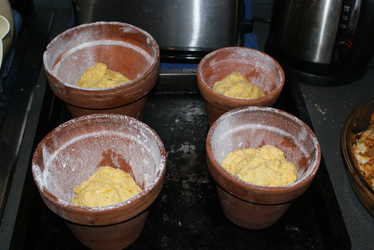
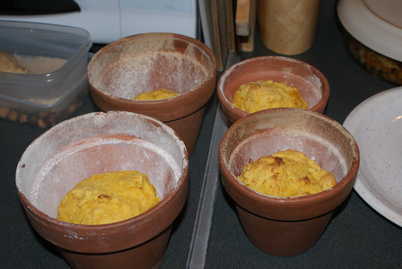

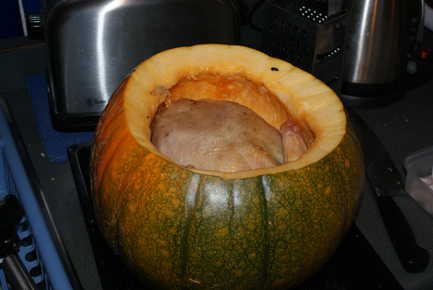
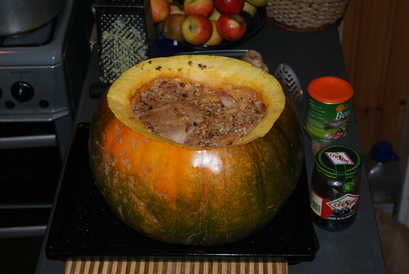
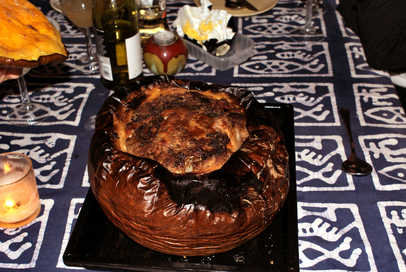
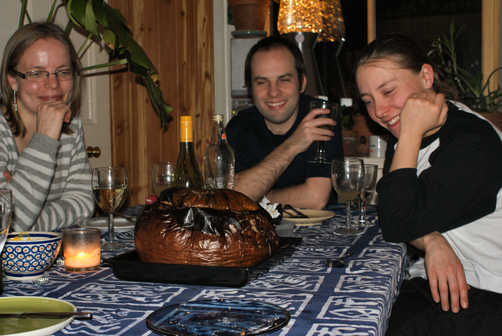
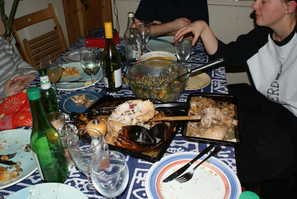
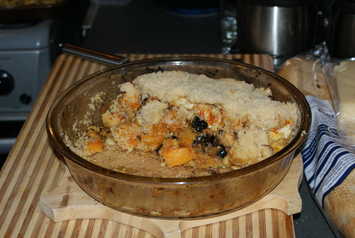
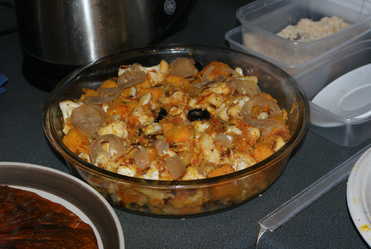
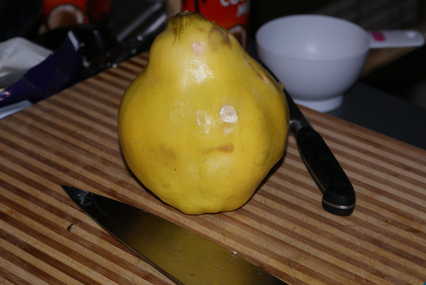
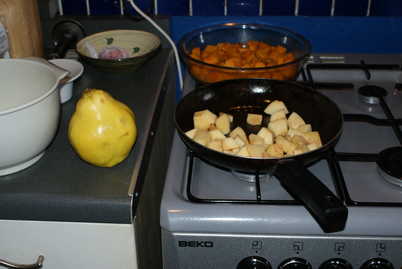
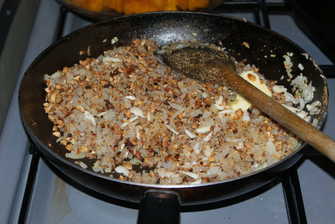
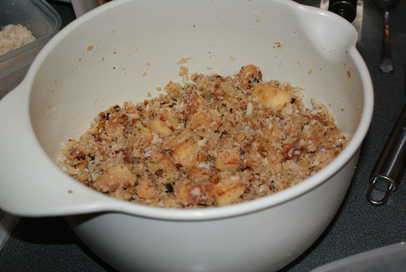
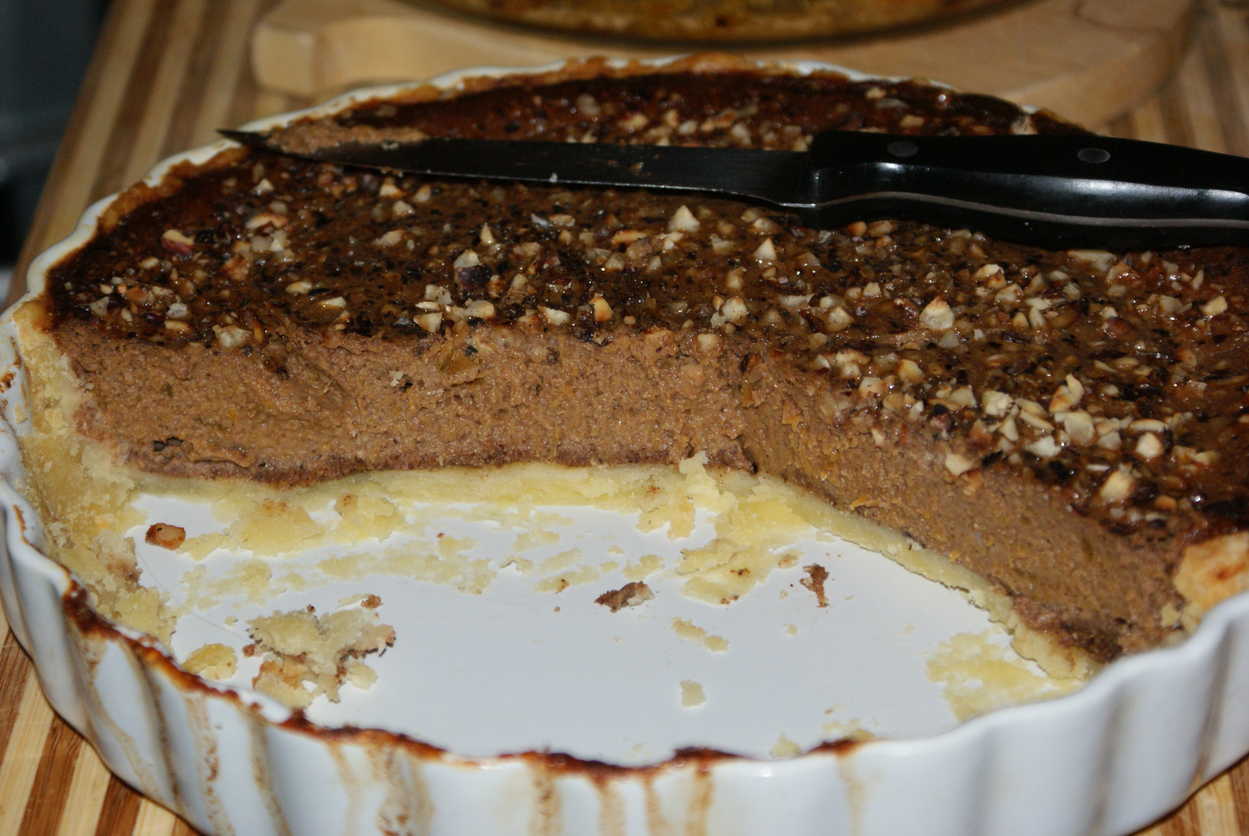
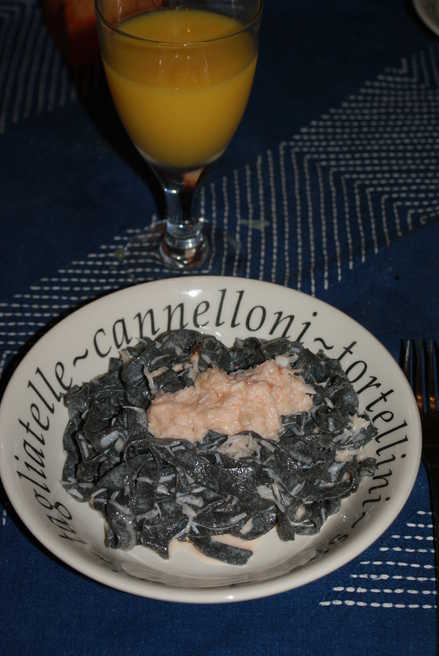

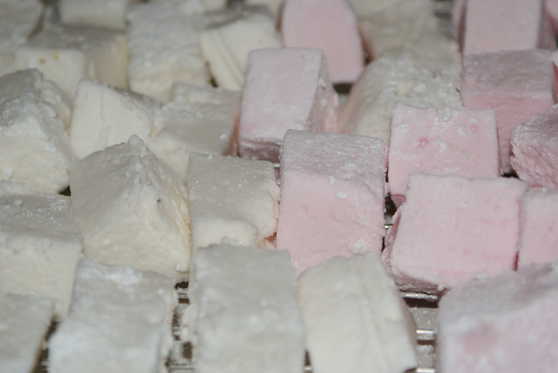
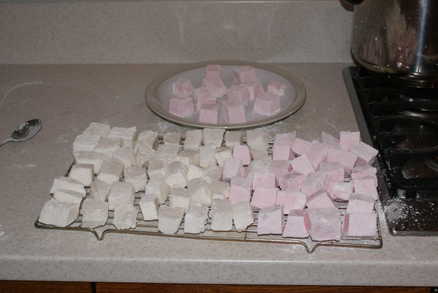
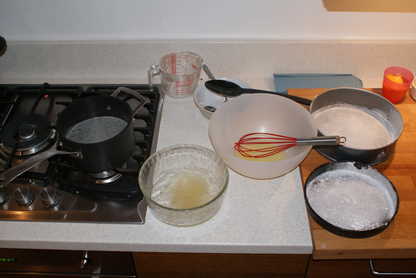
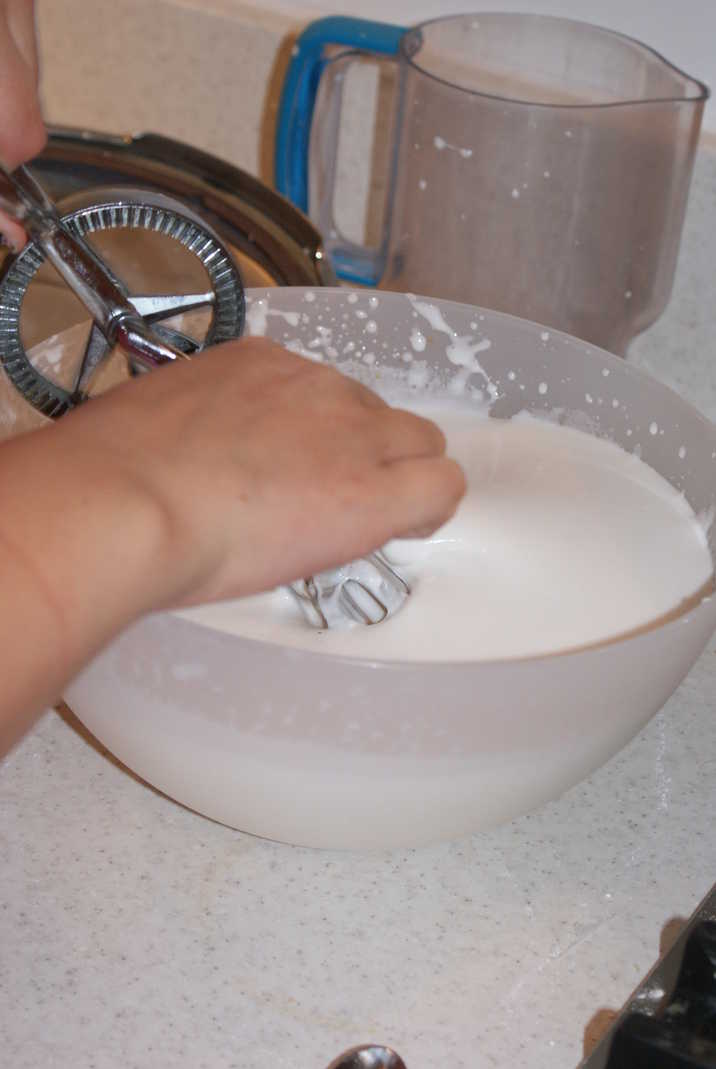
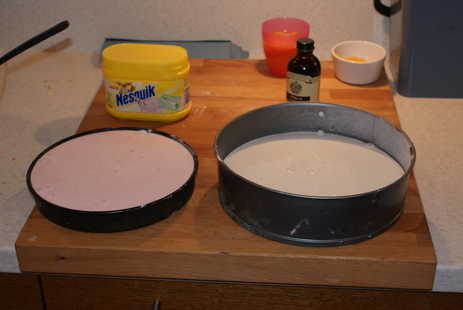
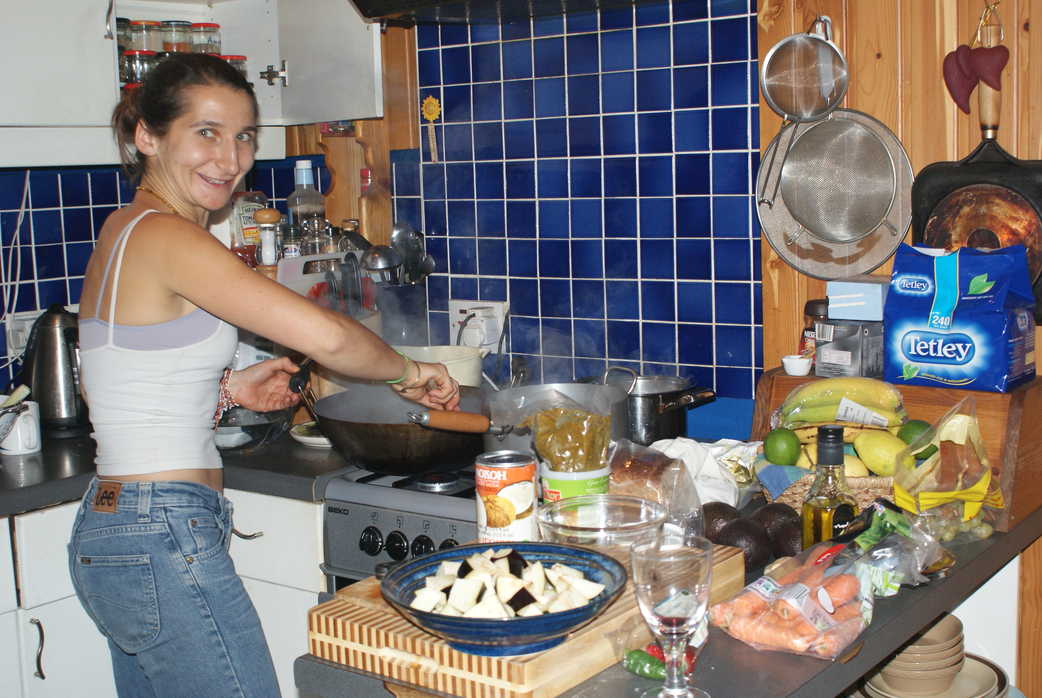
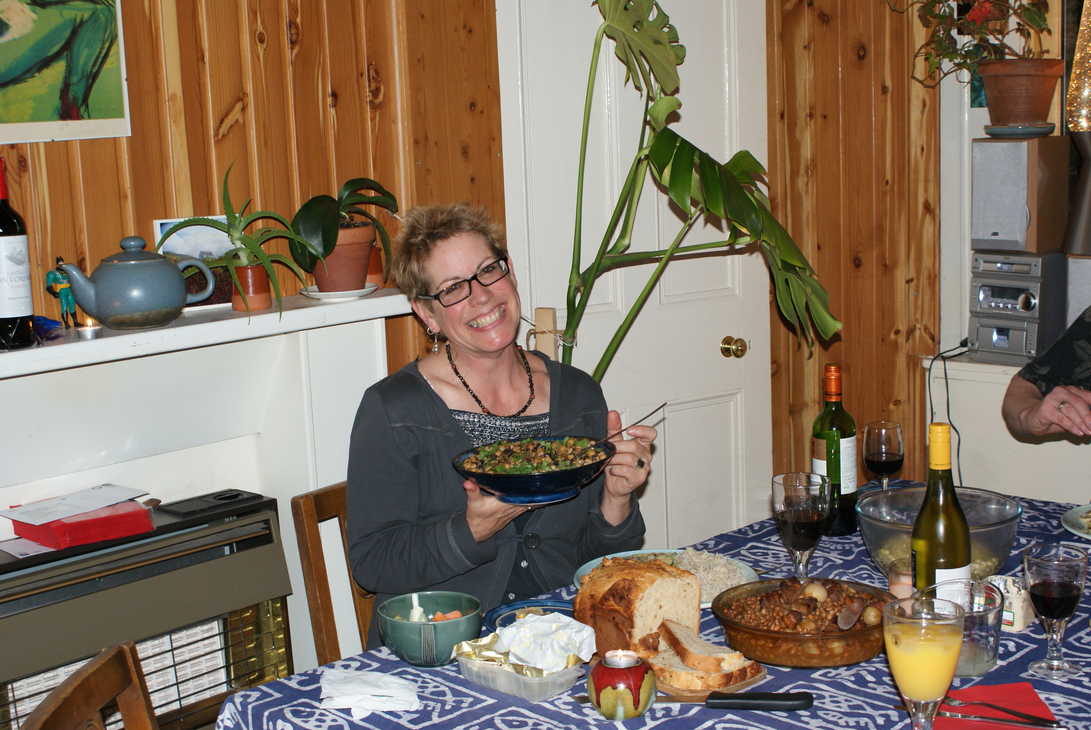
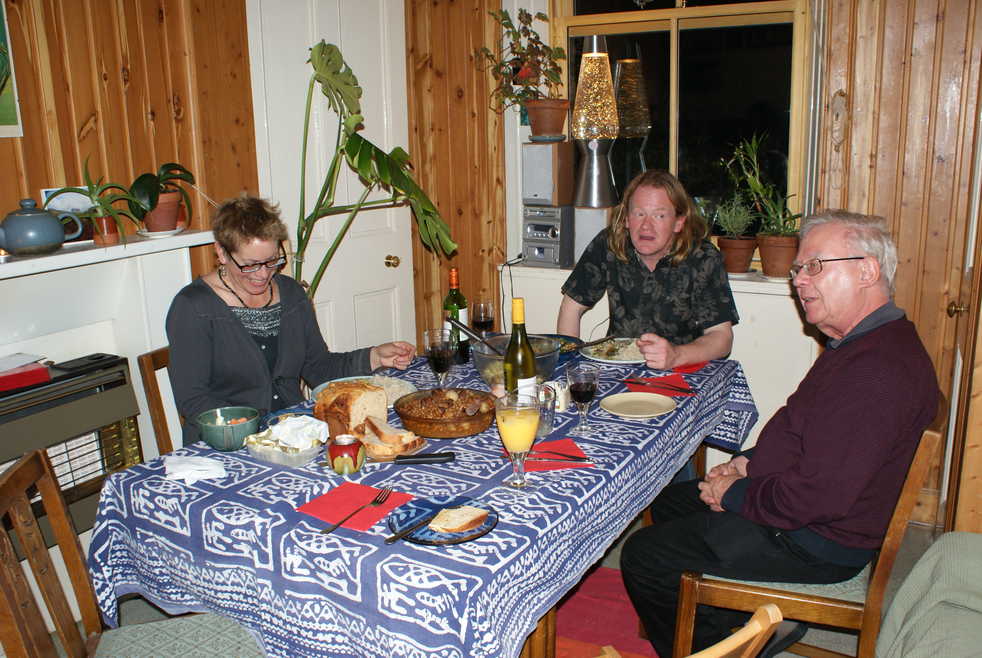
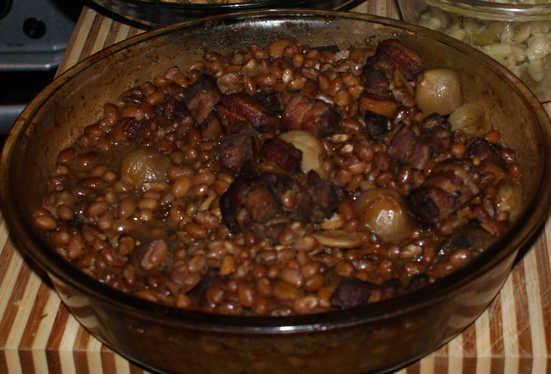
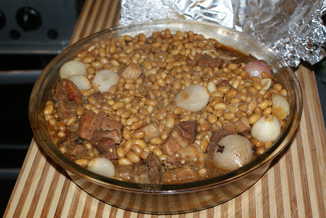
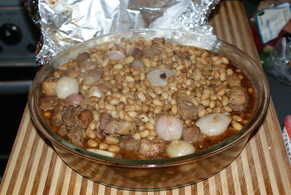
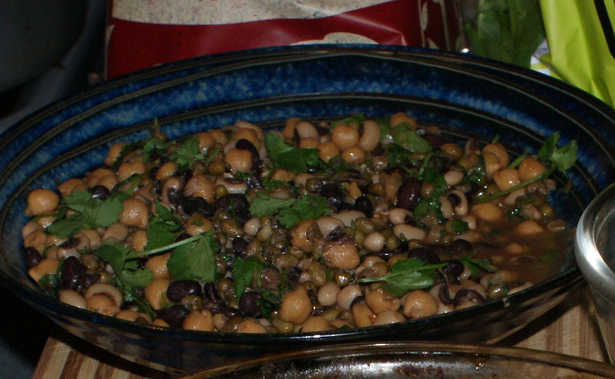
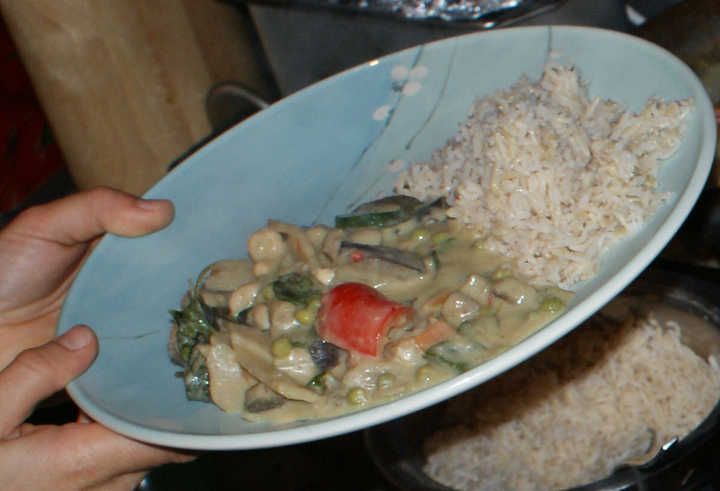
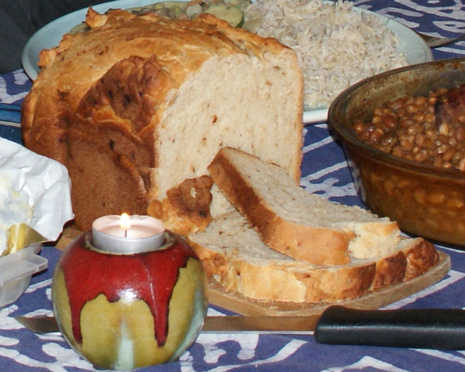
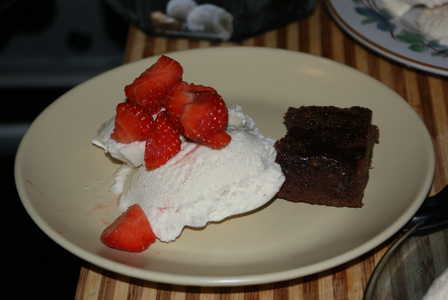
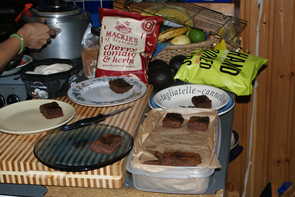
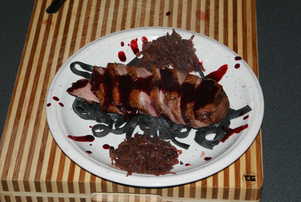
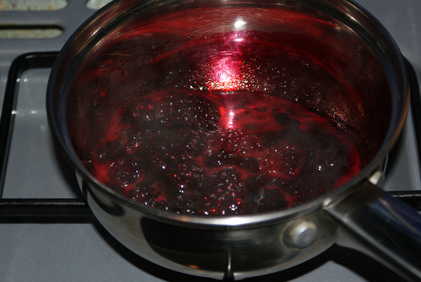
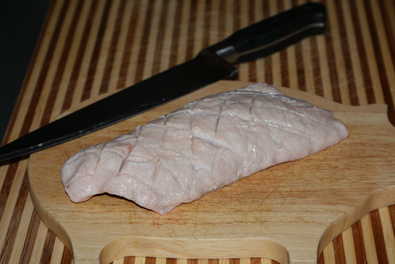
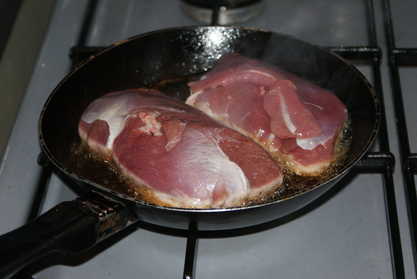
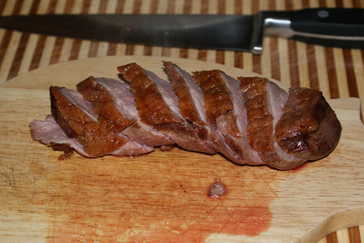
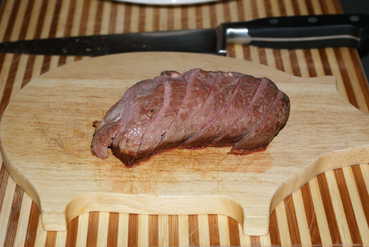
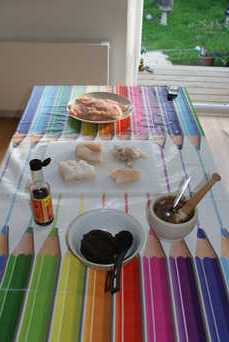
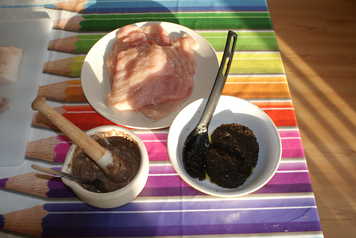
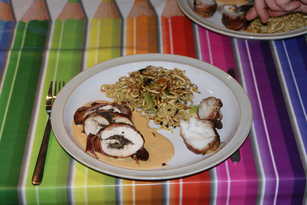
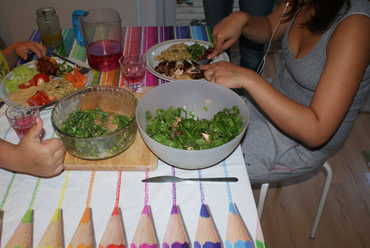
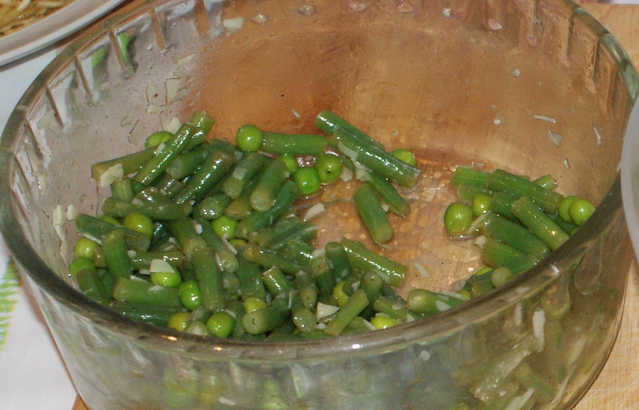
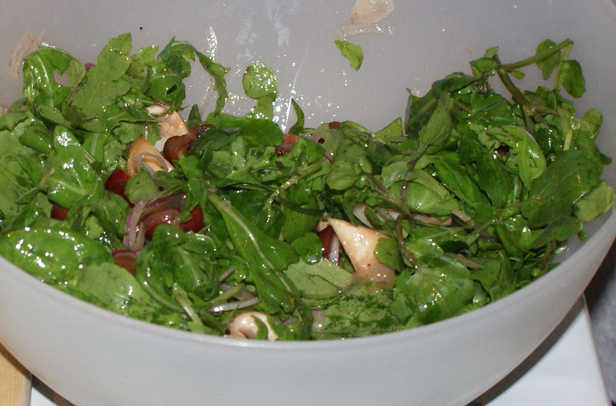
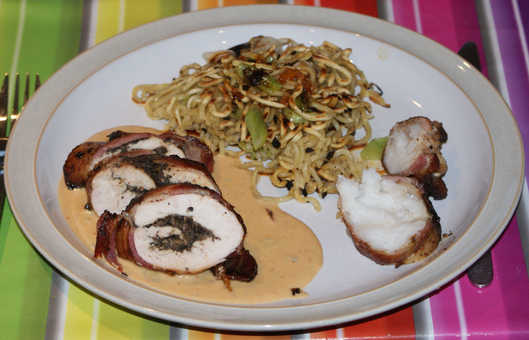
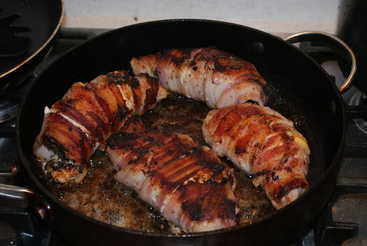
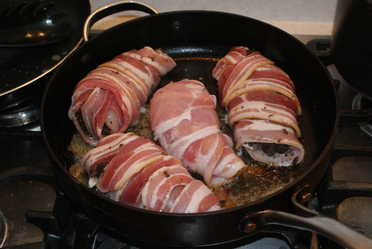
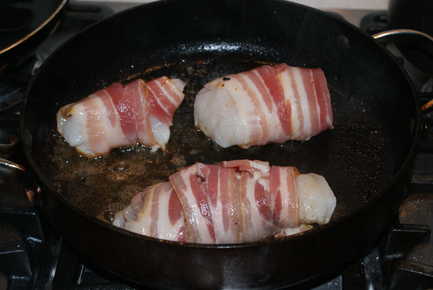
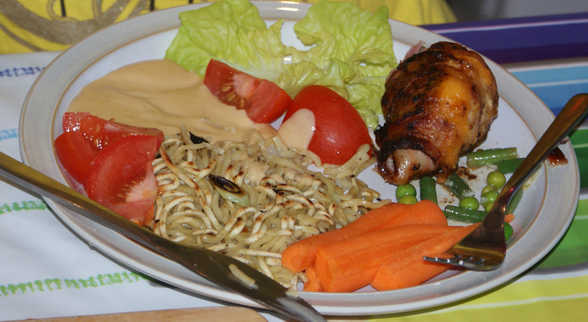
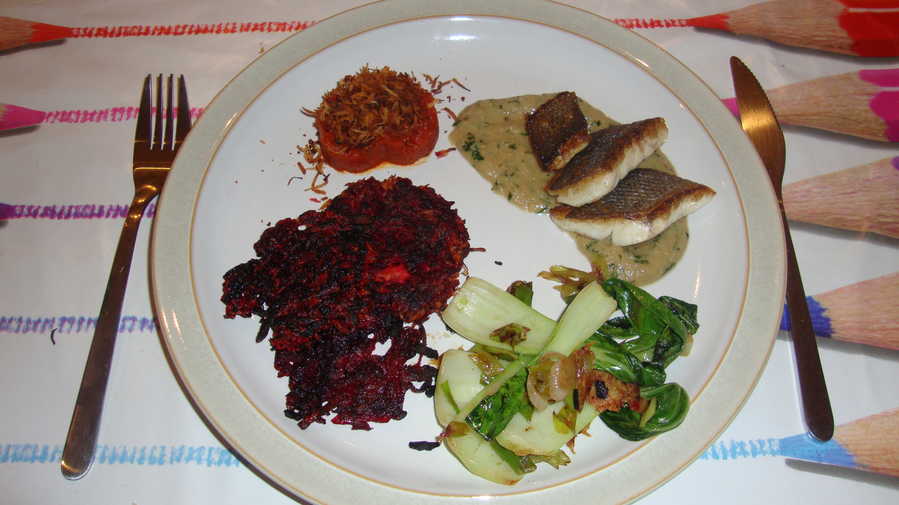
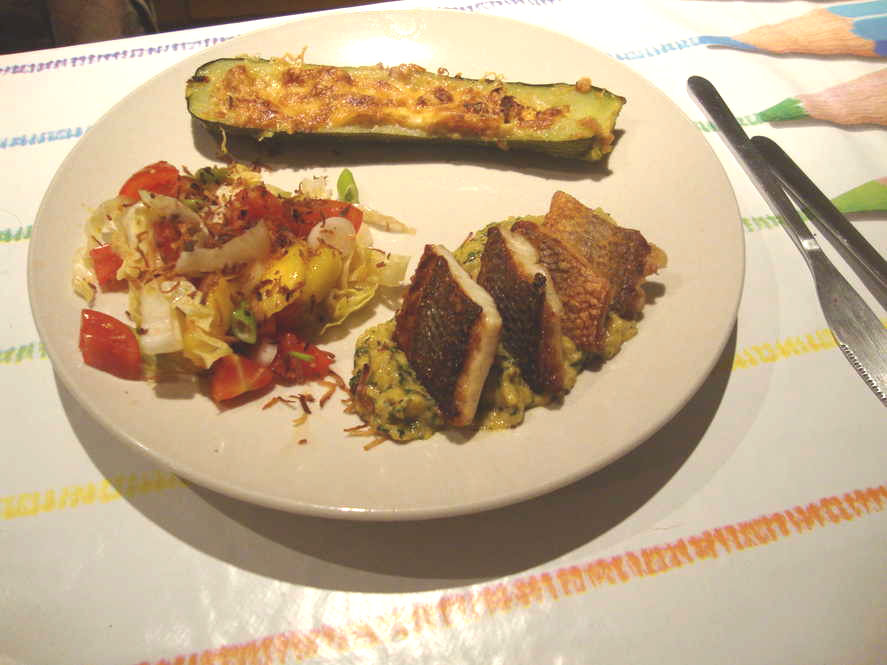
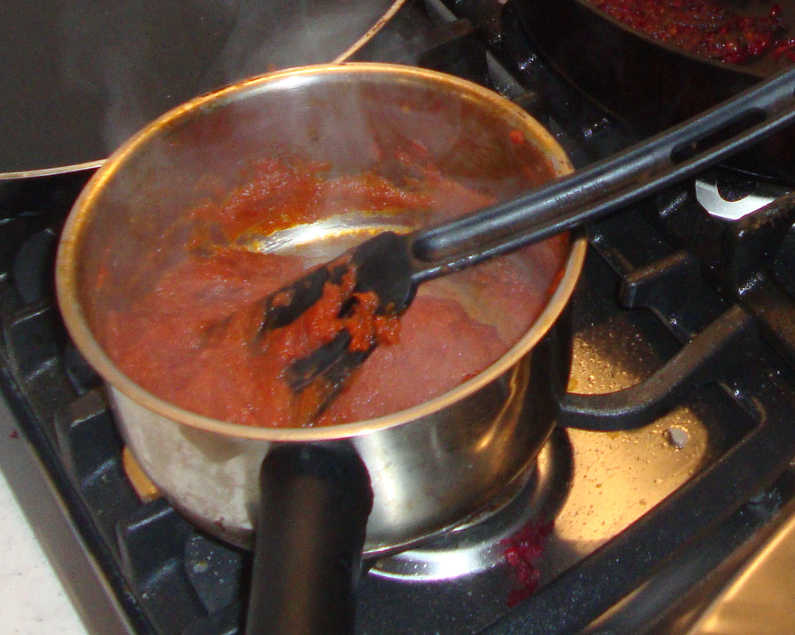
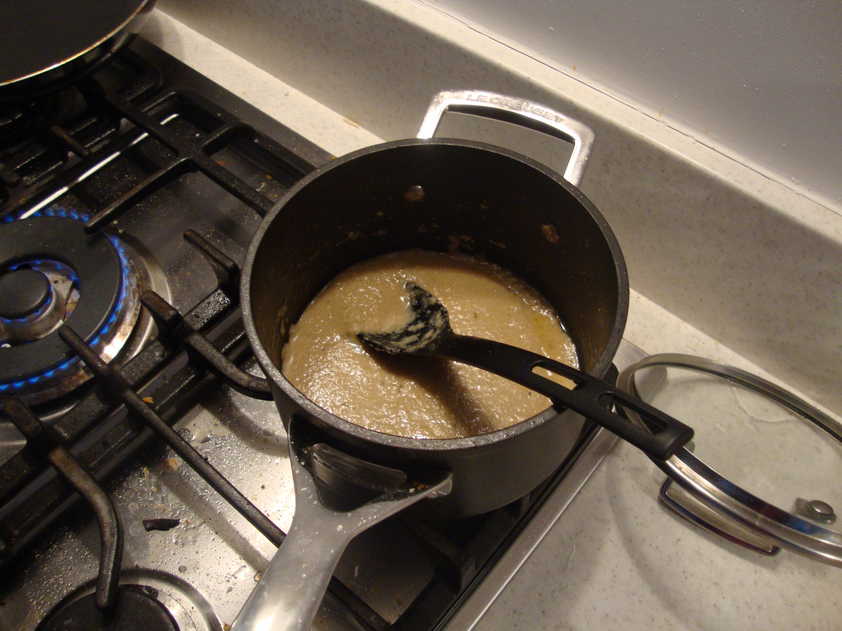
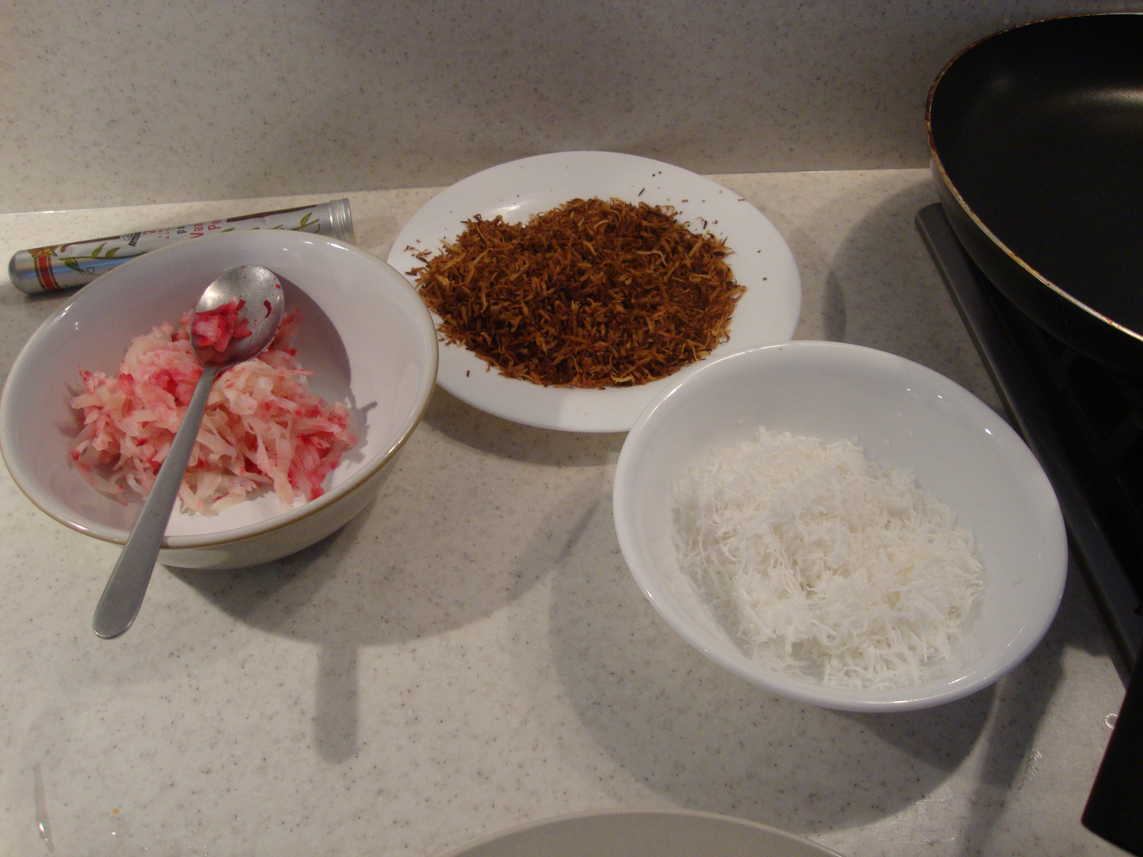
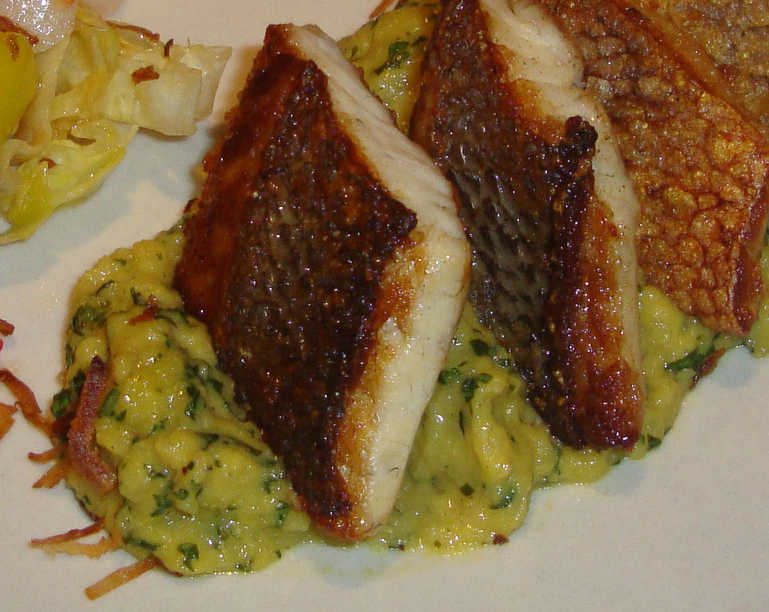
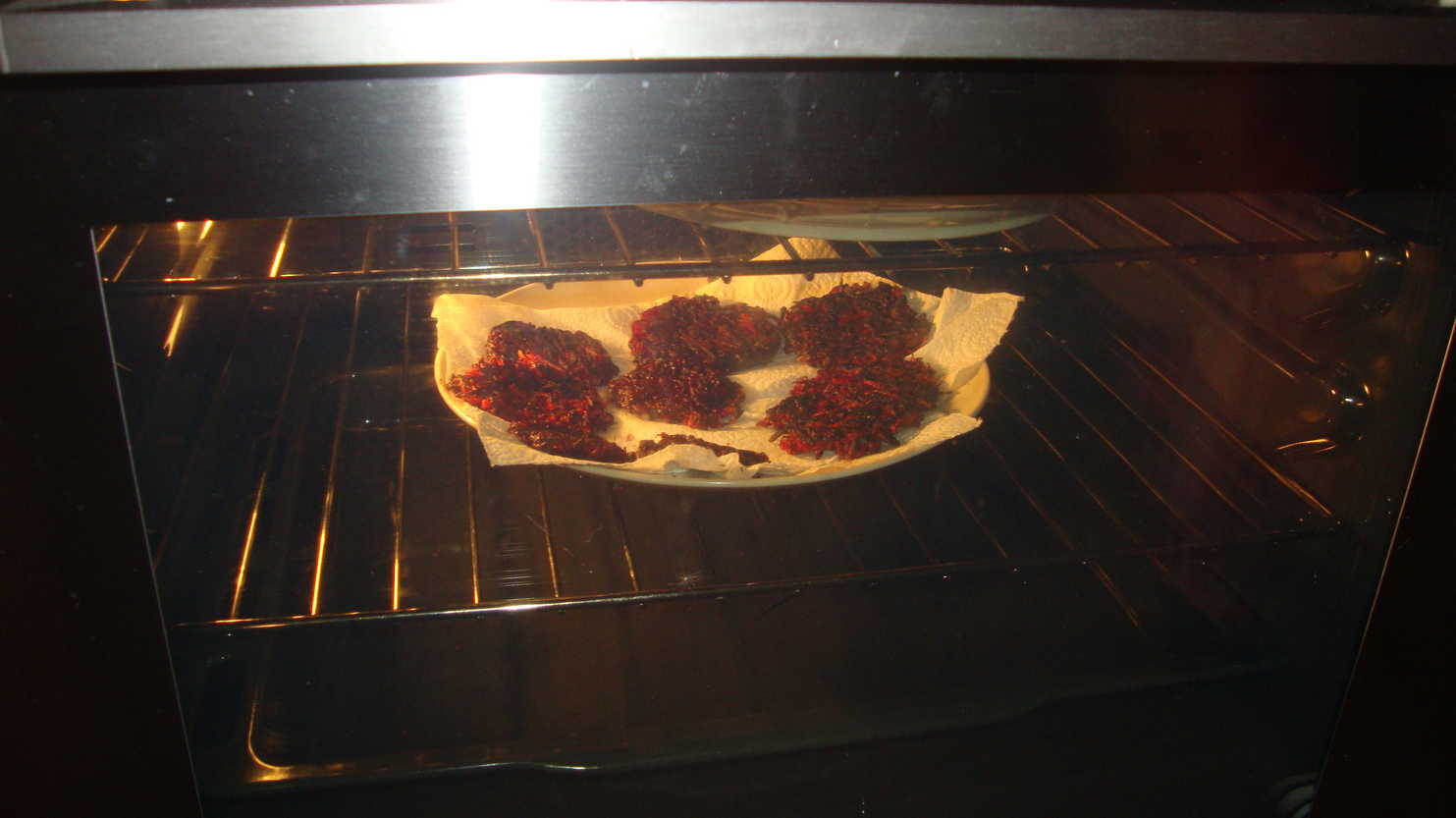
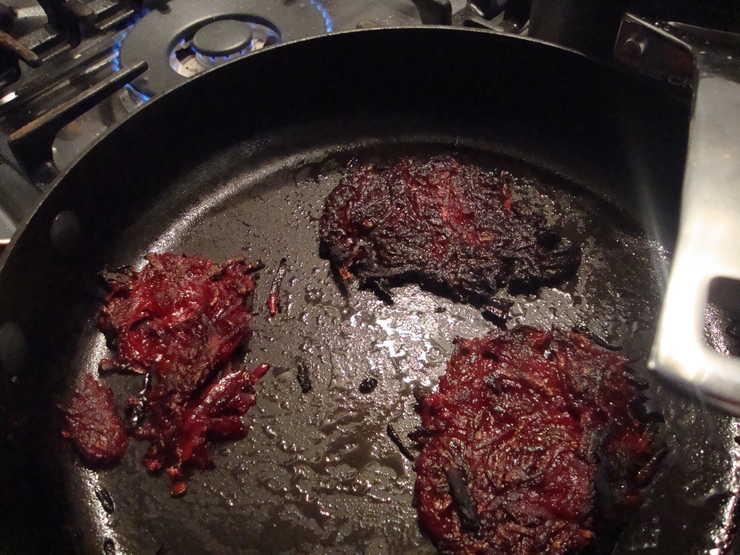
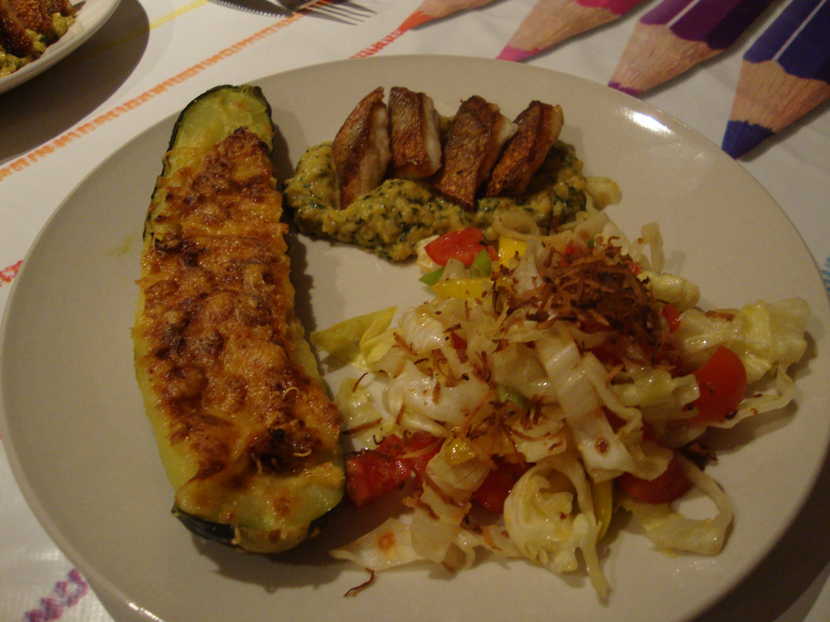
I baked the chumpkin a bit hotter (around Gas 8) for about 20 minutes just to get things going at the start, then reduced to Gas 6, then gradually lowered the heat towards the end as the pumpkin threatened to burn.
As usual, the chicken itself is wonderfully moist and tender and the stuffing inside the chicken was very good, but the stuffing inbetween the chicken and the pumpkin ended up very soggy from all the pumpkin juices.
Leaving (mostly) the lid off the pumpkin during cooking meant that the stuffing near the top of the pumpkin stayed dry and quite edible, and allowed the exposed chicken skin to crisp up nicely too. I think I'll make that a permanent chumpkin method!
I baked the lid separately in the oven for while too, just so I could serve the pumpkin with an equally cooked-looking lid on it if I wanted.